Here’s a Rundown of the Hunting, Camping, and EDC Fixed Blade Knives from Kizer
Kizer has always had good sense with fixed blade design. In the early days the releases were pretty minimal, but around the 2023 mark they started pushing into the space more ambitiously, and now they have a respectable line up of hunting, camping, tactical, and EDC fixed blades that are pretty spectacular.
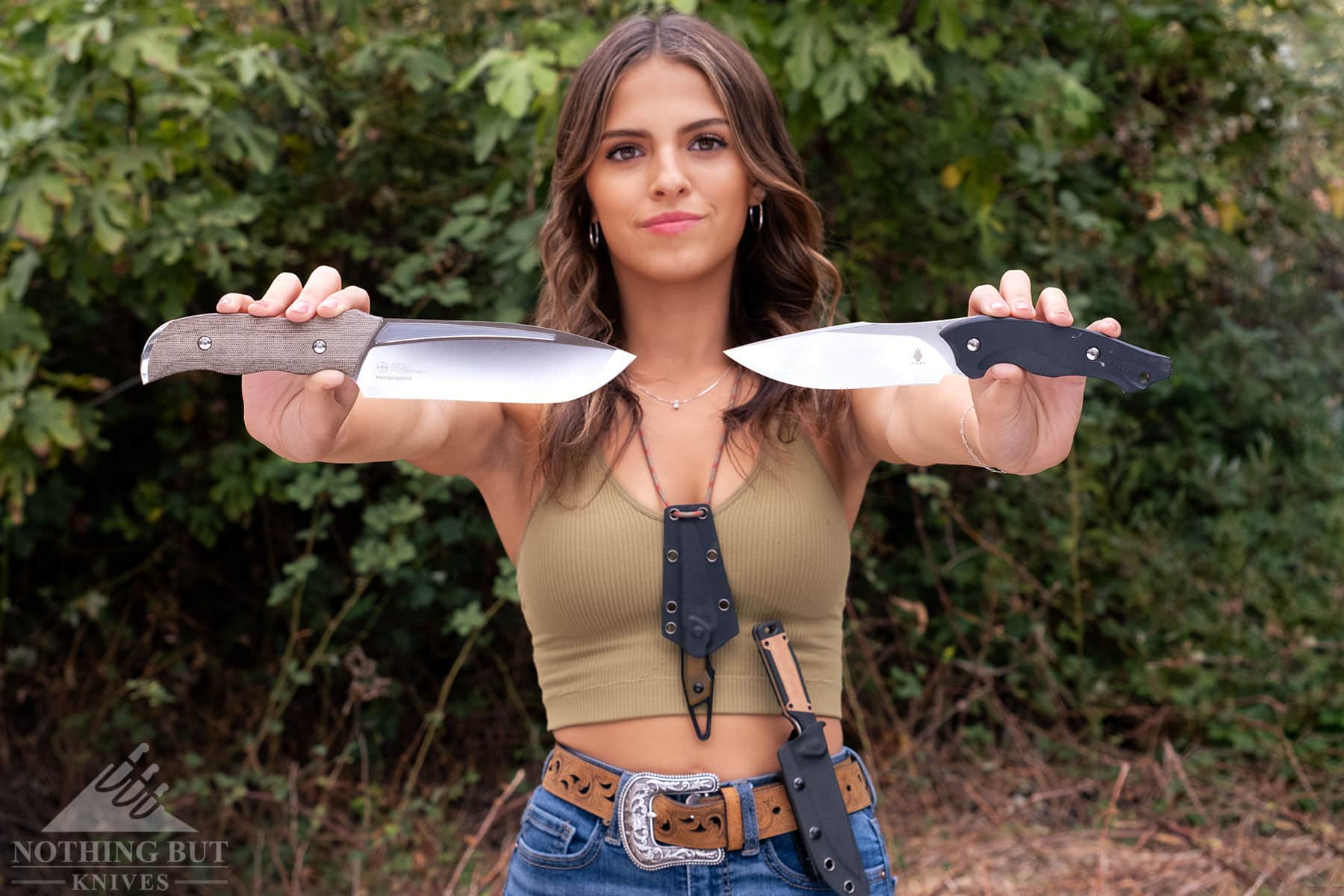
That line up keeps growing, so it’s time there was a guide. This is roughly organized by size, starting with larger knives that are near or over 10 inches overall, then mid-sized knives running in 7 to 9 inches overall, and ending with small, EDC-sized knives under seven inches overall (and usually with a blade under 3 inches).
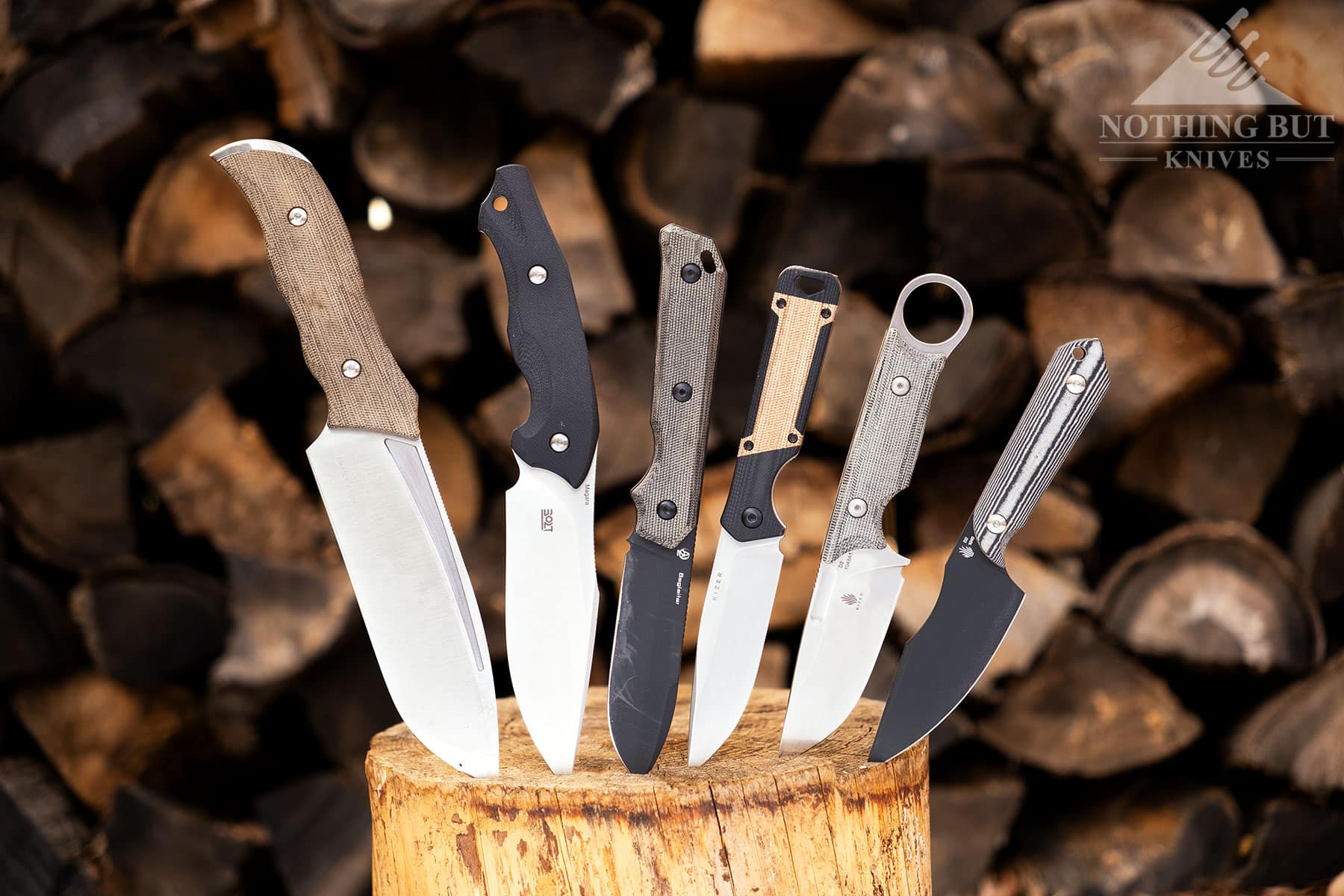
If you’d like a run down on the kinds of clips and straps they use, the difference between Vanguard and Blade Smith Kizers, or an index of the designers and their knives, you can find all that at the end.
Table of Contents
Large Fixed Blades
Metaproptizol
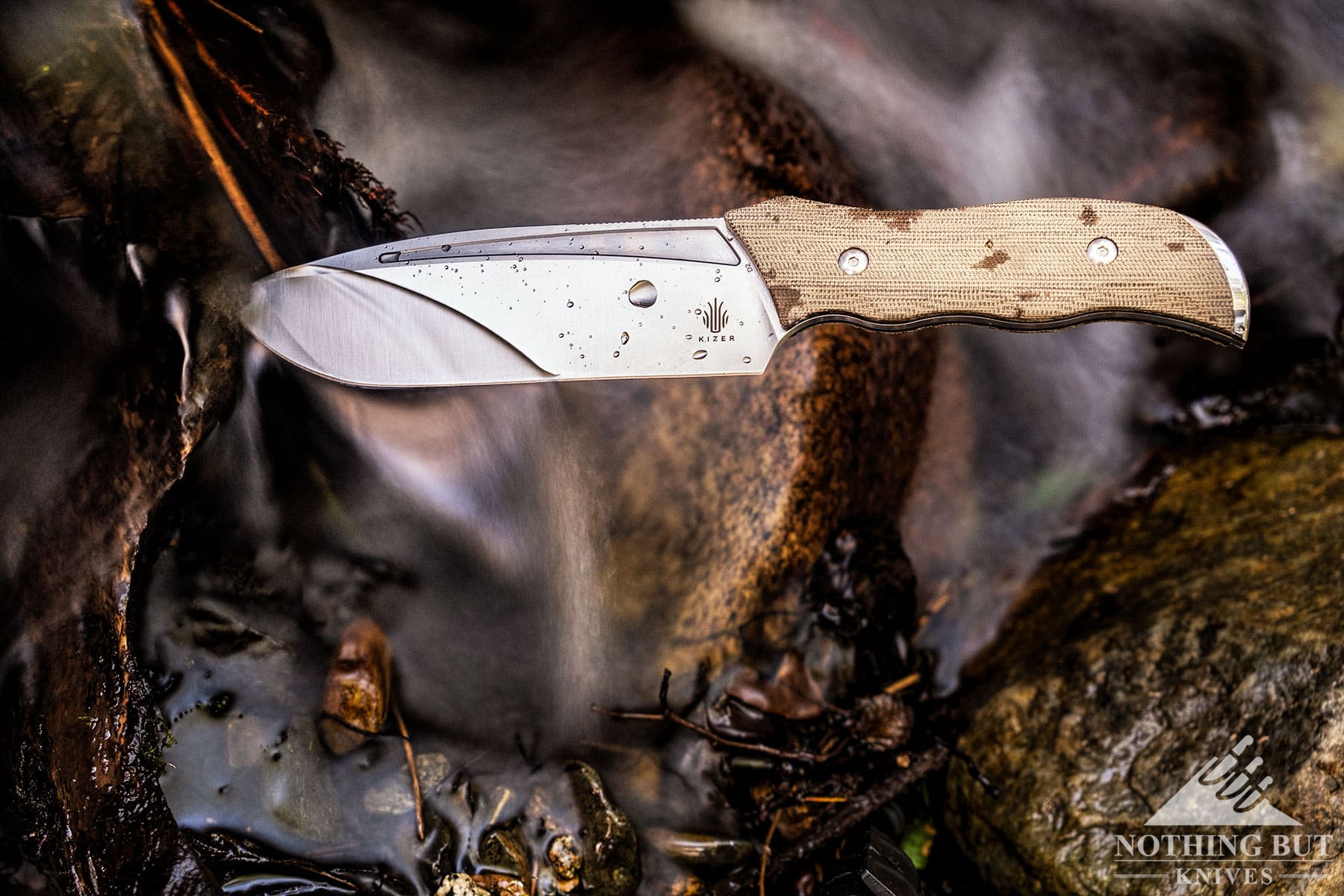
| Stand Out Features | Specifications |
|---|---|
| Big outdoor blade that’s decent at food prep | 10.83” Overall |
| Design for outdoor utility / survival | 5.59” tanto blade / D2 steel |
| Rides on rotating clip | Micarta handle |
| Designed by Adil Musaev | Taco-style Kydex sheath |
This is a military-inspired knife sort of minimalized for outdoor use with a name that comes from a pharmaceutical drug for treating anxiety. So it’s pretty interesting just from a design-imprint perspective.
The blade has a lot of height, so it’s a really fine slicer that’s reasonably good for food prep. It’s kinda good for everything except chopping through logs and batoning. It has a tendency to bite and stick, and then you just have a knife stuck in a log.
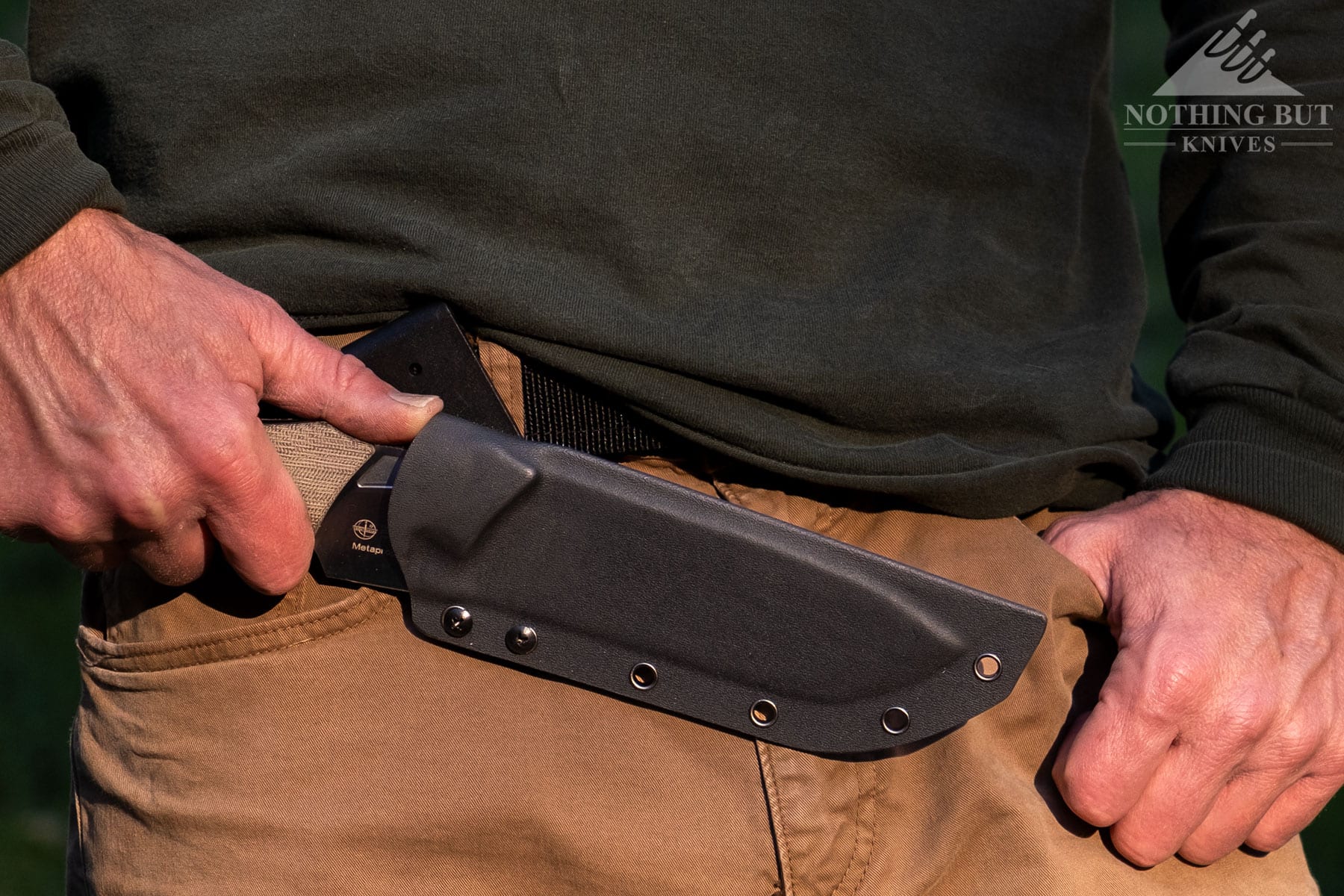
The handle is thin for the size, and the corners can be somewhat harsh as a result. If it were made of anything harder than Micarta it would be a pretty harsh ergonomic experience. Other than that, it has a good grippy texture and the waves in the handle help that grip more than hinder.
They list it as having a “tanto” blade, and there is definitely a steeper grind at the tip that’s useful for all kinds of things, but not in the way that a typical tanto blade is. It brings up some tricky semantics that we don’t care to get into here, but the blade is cool either way.
Magara
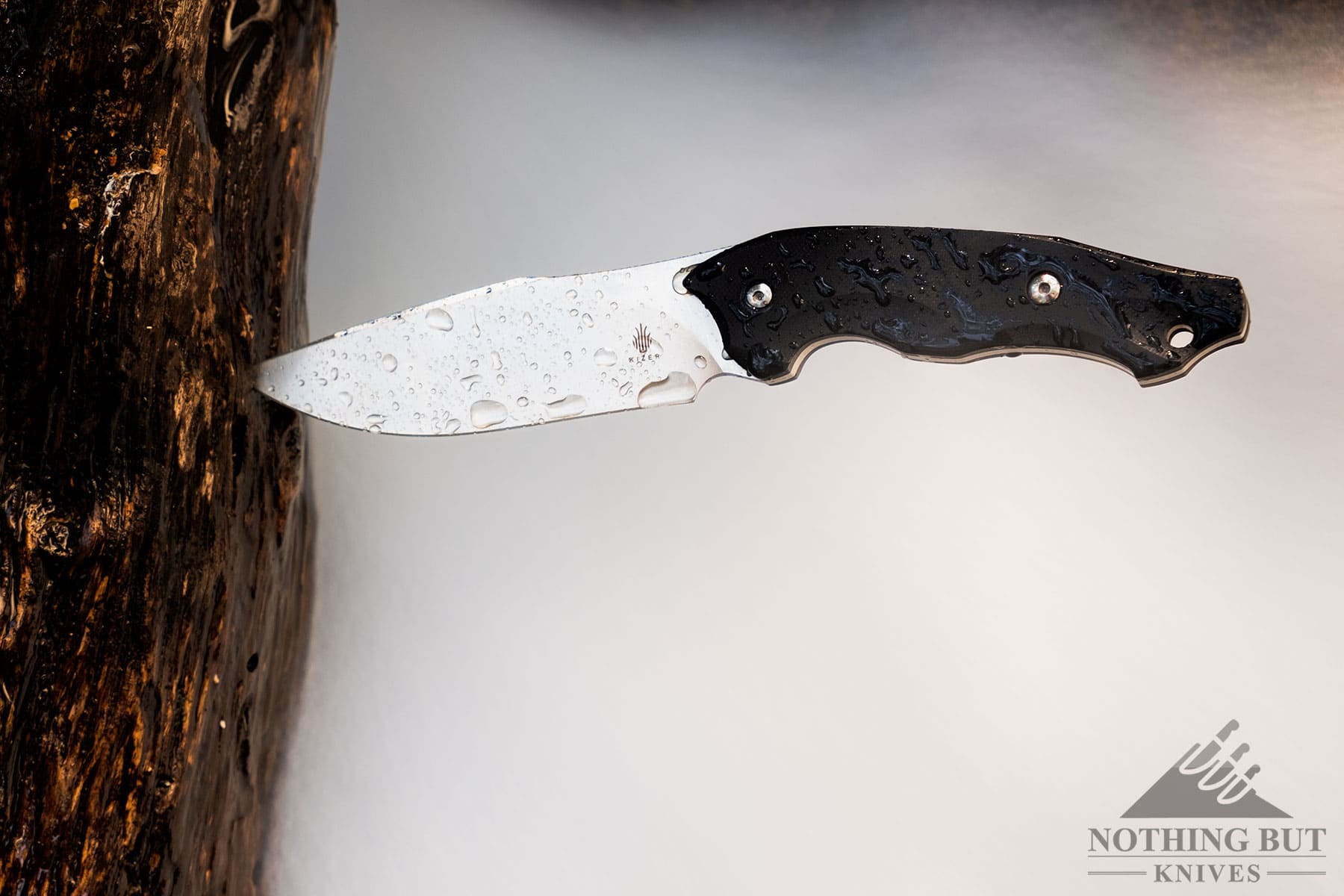
| Stand Out Features | Specifications |
|---|---|
| A mean blade and a tight-grip handle | 9.84” Overall |
| Designed for tactical and outdoor use | 4.76” clip point blade / D2 steel |
| Carries on rotating clip | G10 handle scales |
| Designed by Artur Szula | Pancake-style Kydex |
The Magara wants very badly for you to have a secure grip. If the handle fits your hand, that’s great. If it doesn’t, it feels more like the handle is trying to push your hand away.
Once that comfort hurdle is cleared, though, this can be a really fun knife. Designed by Arutur Szula who was inspired by the Crocodile Dundee bowie, the Magara is pointy and slashy, and just a lot of things you want a knife to be when you want to pack one that is very obviously a knife.
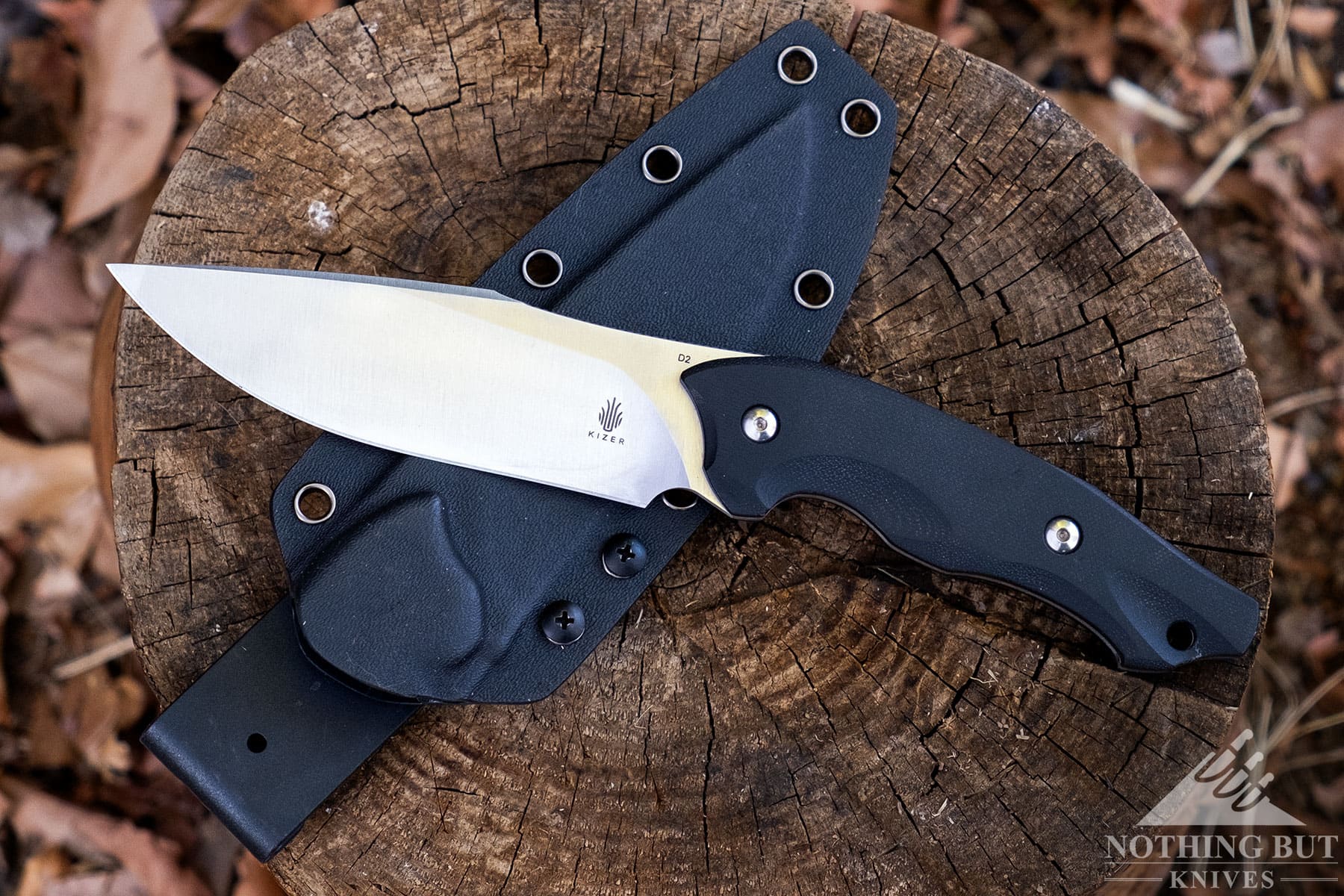
The sheath retention can be pretty a little too tight sometimes, but that will loosen up over time and it’s on Kizer’s rotating belt clip, so you shift it into a more comfortable position when you draw.
Overall it’s a slicey, low-cost design. It can be tough to work with the handle, though.
Mid-Sized Fixed Blades
Militaw Fixed Blade
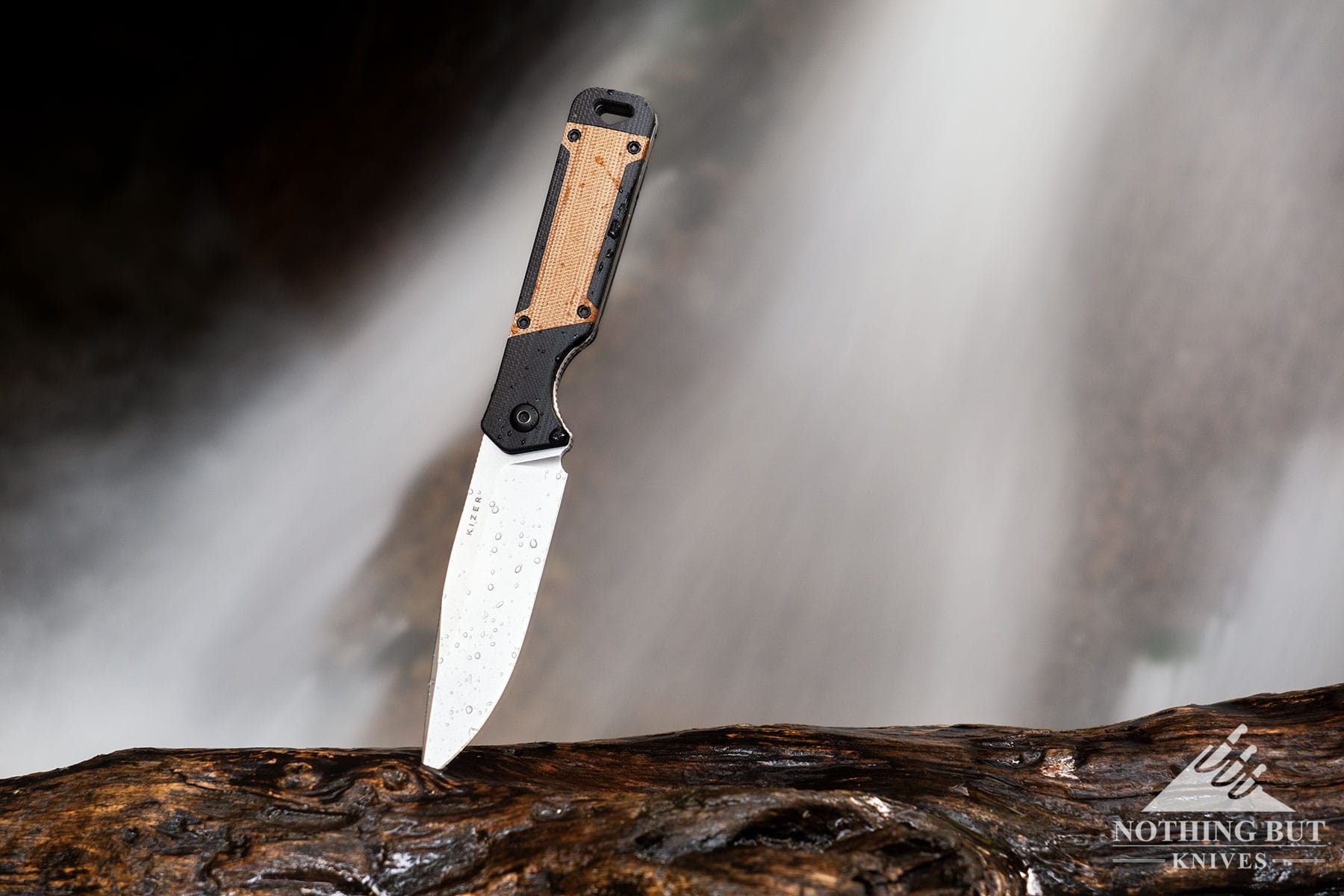
| Stand Out Features | Specifications |
|---|---|
| Compact design with good balance | 8.18” Overall |
| Designed for camping and hunting | 3.83 drop point blade / Nitro-V or S35VN steel |
| Carries on button-lock clasp | G10 w/ Micarta inserts or aluminum w/ Fat Carbon |
| Designed by Jonathan Styles | Taco-style Kydex sheath |
Kizer’s popular tactical-style folder turns out to be a good basis for a fixed blade knife. The design lines are all pretty much exactly the same:
It has a squared off handle (which is great for controlling the blade, even if it isn’t always the most comfortable arrangement), the patterning for different colors and materials are the same, and the drop point blade lines up almost inch for inch.
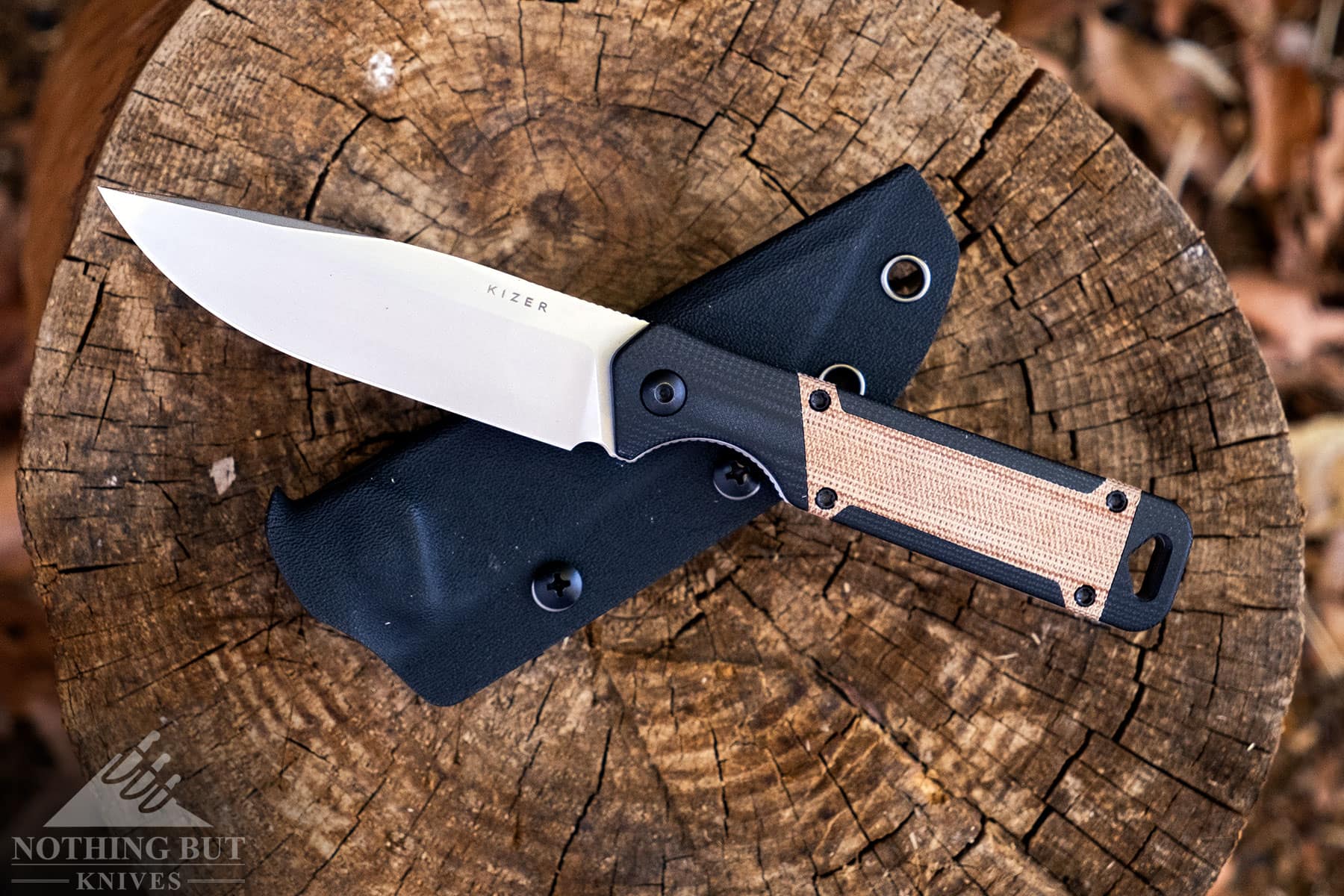
I think anyone who already owns a Militaw wouldn’t be surprised at the easy translation. The wild card was the sheath.
There you have a taco-style arrangement with a Tek Lok-style clip. This would make it really versatile, since the knife is reasonably light for the size, except that the holes in the sheath don’t seem to line up for horizontal carry.
Still. It’s a good candidate for some kind of multi-clip solution, and if you have a MOLLE system, it works well enough as a chest carry.
Cabox
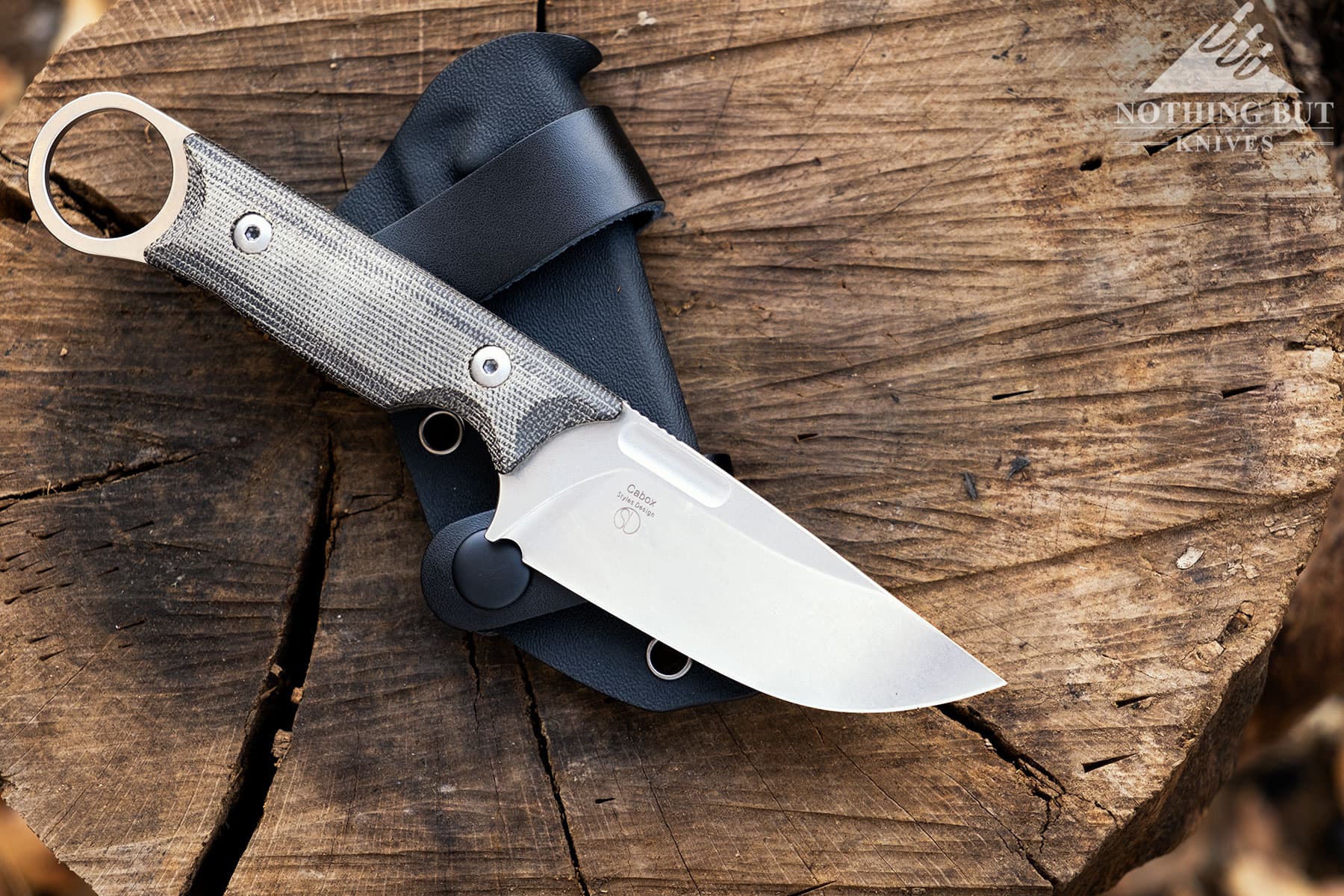
| Stand Out Features | Specifications |
|---|---|
| Tall blade on a short ring kife | 8.11” overall |
| Designed for skinning and outdoor use | 3.36” drop point blade / D2 steel |
| Rides on leather straps | Micarta handle scales |
| Designed by Jonathan Styles | Taco-style sheath |
A lot of possibilities get opened up by a tall blade, and that’s certainly what the Cabox has, at least, for a slight-over-three-inch blade.
Food prep gets easier, both because there’s more blade to scoop up food, but also because the height leaves more room for a gradual primary grind, and that tends to make the cutting action feel a lot smoother. Plus, the fuller should help reduce food stick.
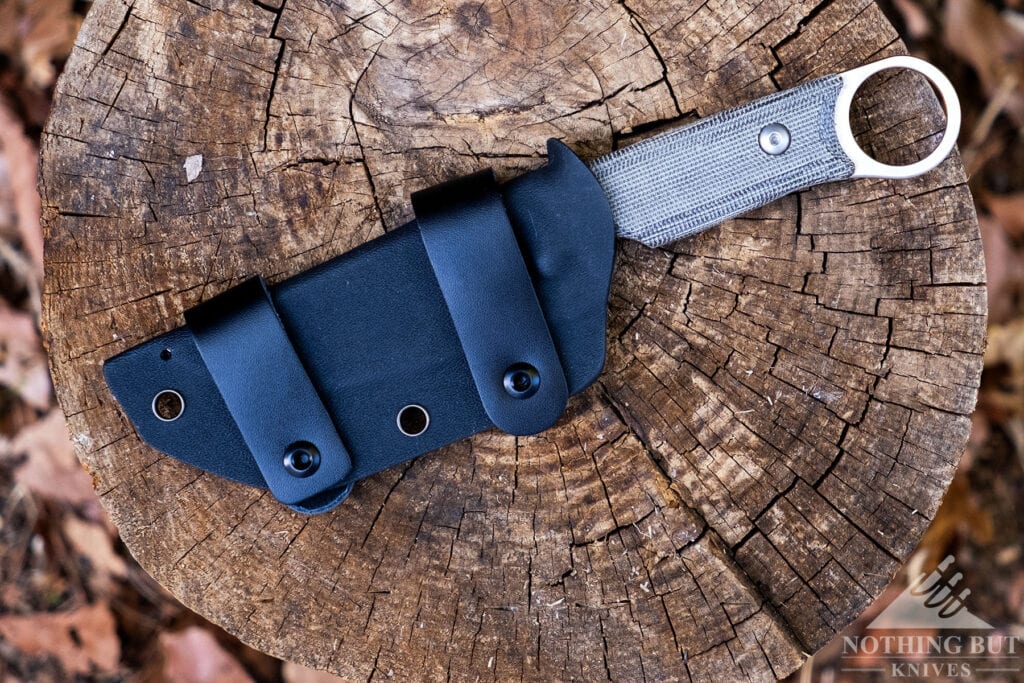
It was designed as a skinning knife, though, which a tall blade can also help with (depending on what you’re skinning). Between the D2 steel and the geometry, the blade has a good amount of wear resistance, and the handle works well in a few different grips besides the standard hammer.
It stands out from a lot of other ring knives in that the ring in the pommel is not a required part of the ergonomics to hold that knife. You can hold it just like any other knife and it’s perfectly comfortable. That ring is pretty much only there to help deploy the knife.
Sou’Wes’
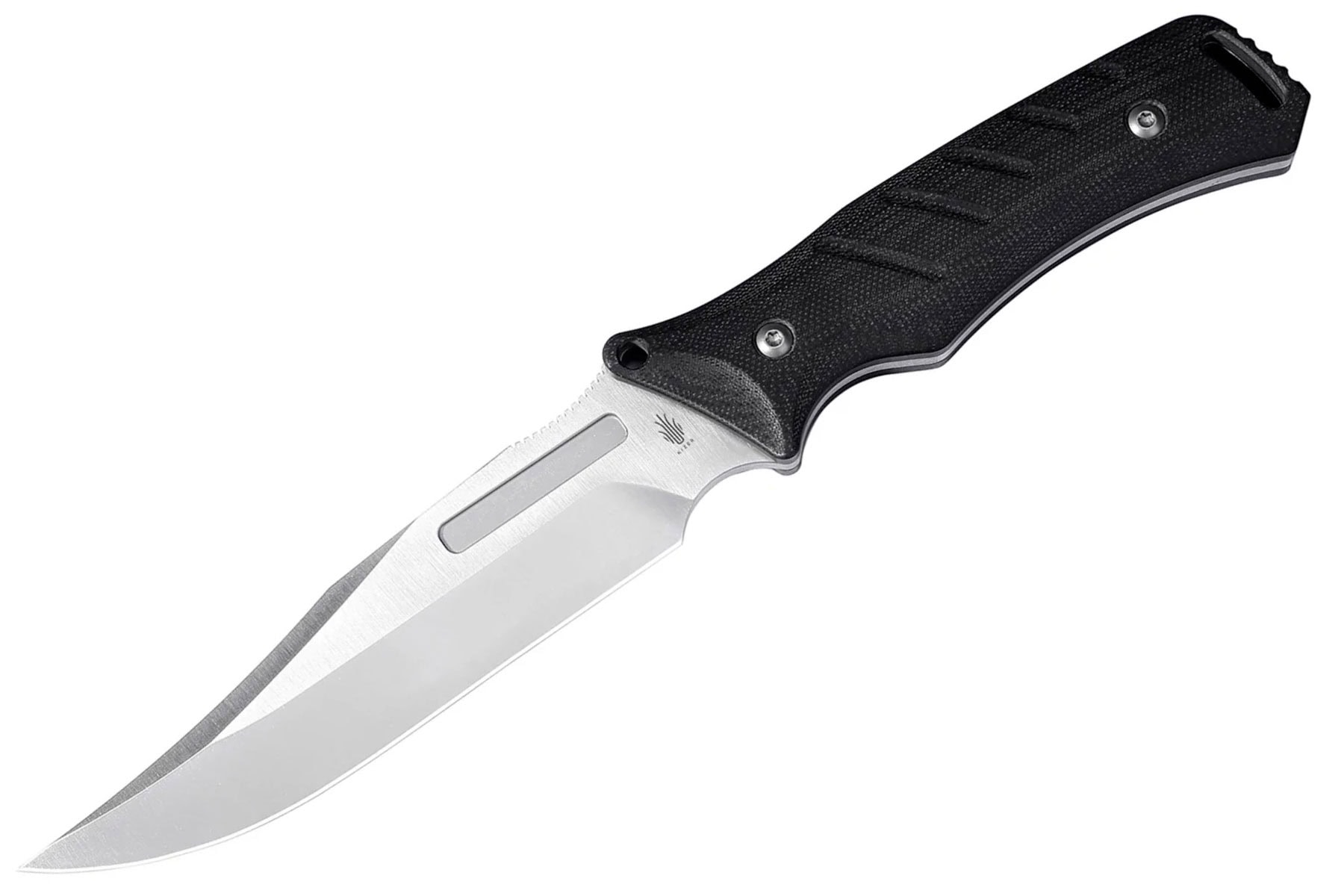
| Stand out features | Specifications |
|---|---|
| Mid-sized bowie | 9.17” overall |
| Designed for hunting and outdoors | 4.65” clip point blade / D2 steel |
| Carries on leather straps | G10 handle scales |
| Designed by Jonathan Styles | Taco-style Kydex sheath |
This is one of the few options in Kizer’s fixed blade selection that could be considered a Bowie.
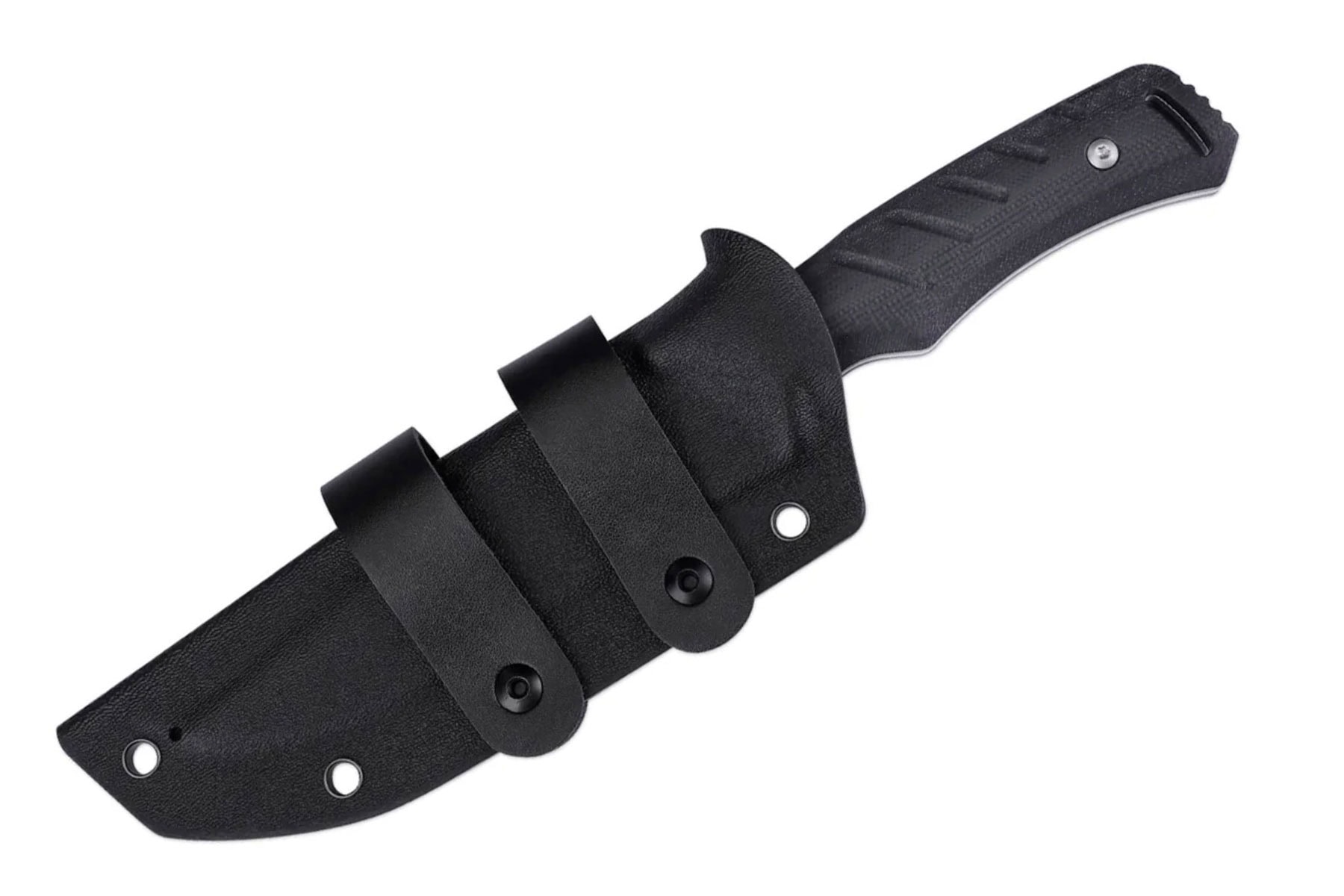
The handle has plenty of room to grip, and manages to stay fairly neutral in spite of the finger groove, which allows for a pretty comfortable grip with choking up on the blade. Tactical as this may look at first, the intent is hunting and general outdoor use.
The sheath is simple enough with a taco-style formation and a
Begleiter Fixed Blade
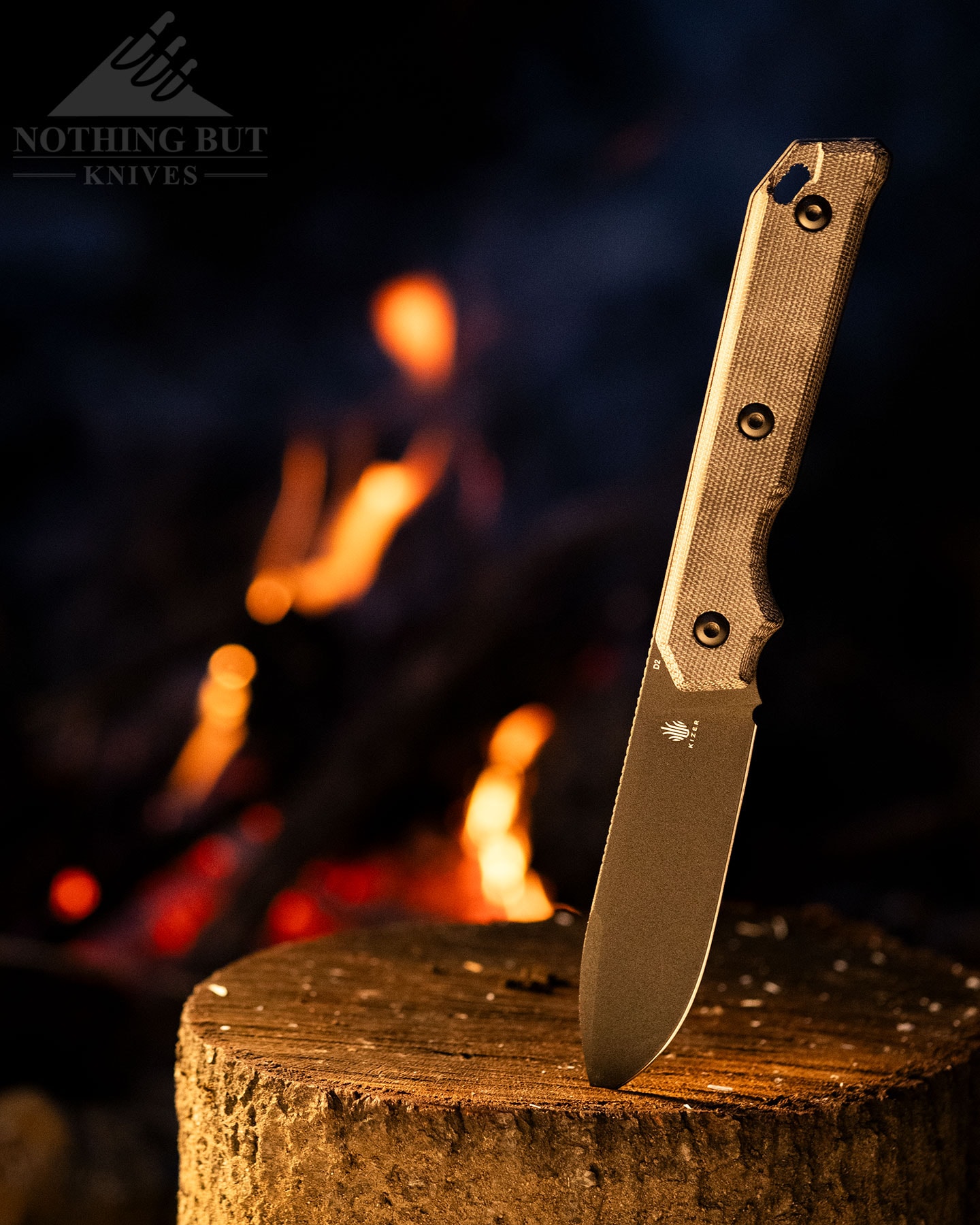
| Stand Out Features | Specifications |
|---|---|
| Exceptionally comfortable | 8.77” overall |
| Designed for EDC and general outdoor | 3.77” drop point blade / D2 steel |
| Rides on leather loops | Micarta handle scales |
| Designed by Azo Mai | Taco-style Kydex sheath |
The fixed blade version traveled a fair bit of distance from the folder design it’s named after:
The point of the blade drops lower, it’s nearly an inch longer overall, and they’ve added a whole extra finger choil in the handle. The tying element between the two is in the shape of the pommel where they share squared off lines and a lanyard hole.
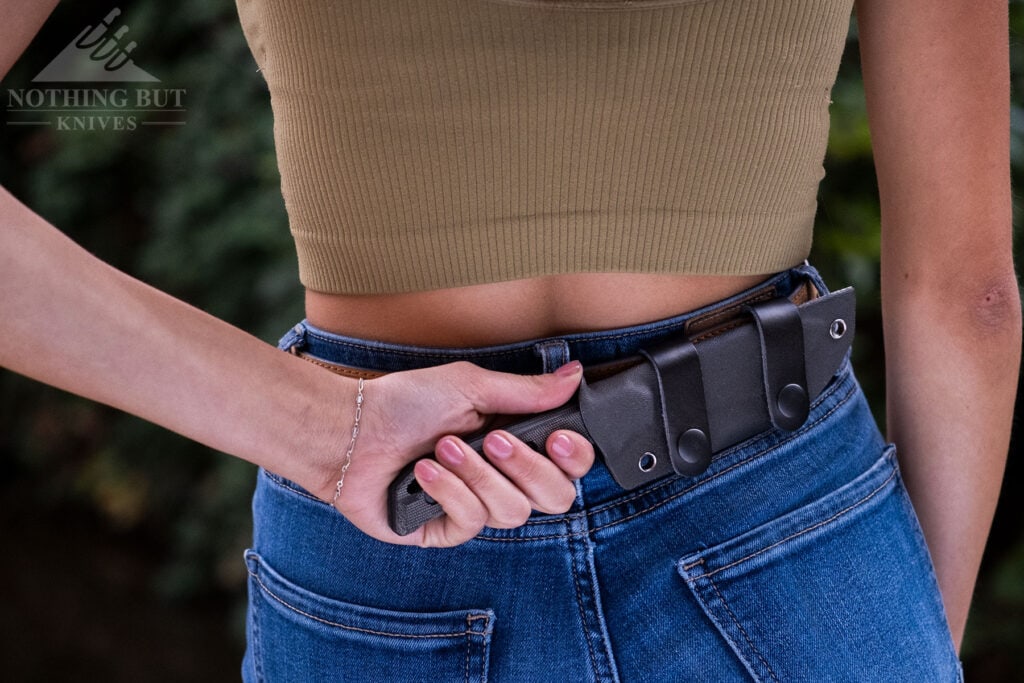
Whatever its origins are though, the fixed blade Begleiter is incredibly comfortable with grippy Micarta scales that are sort of beveled. The handle has a lot of room for different grips, and pretty much every grip feels easy.
For the sheath you get what seems to be standard for Kizer fixed blades in this size: taco-style Kydex with leather loops.
Hare
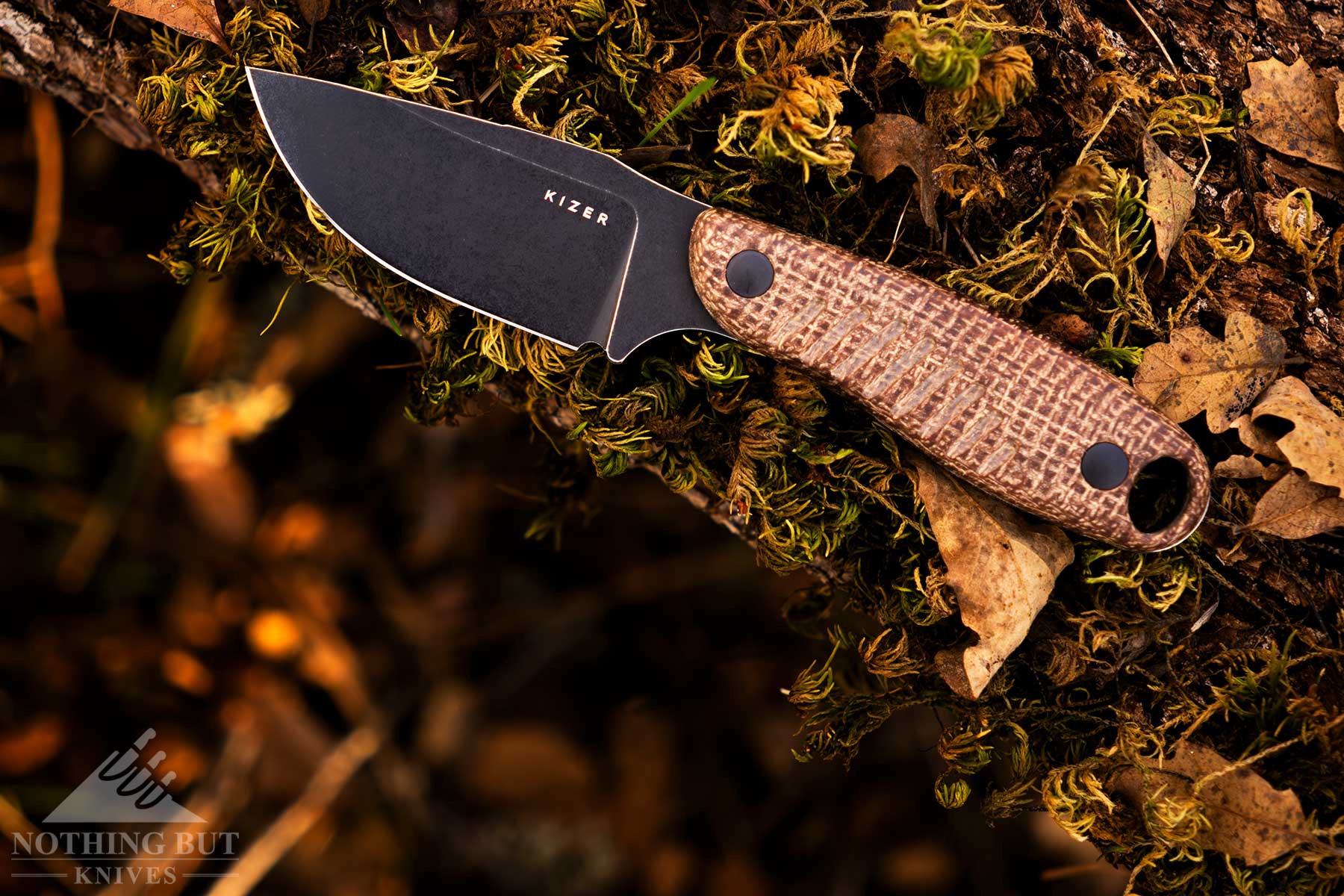
| Stand Out Features | Specifications |
|---|---|
| Tough and comfortable | 7.8” overall |
| Designed for EDC, general outdoor activity | 3.86” clip point blade / D2 or Nitro V steel |
| Carries on button-lock clip | G10 or Micarta handle scales |
| Designed by Azo Mai | Pancake Kydex sheath |
I suppose I could make an attempt at starting a controversy by calling the Hare the “Izula 2 killer”. That would be a bit hyperbolic, but the similarities are undeniable. The Hare is certainly different enough to be its own thing, and the Izula 2 could use a bit more competition, so I am stoked Kizer and Azo collaborated on this mid-sized camping fixed blade.
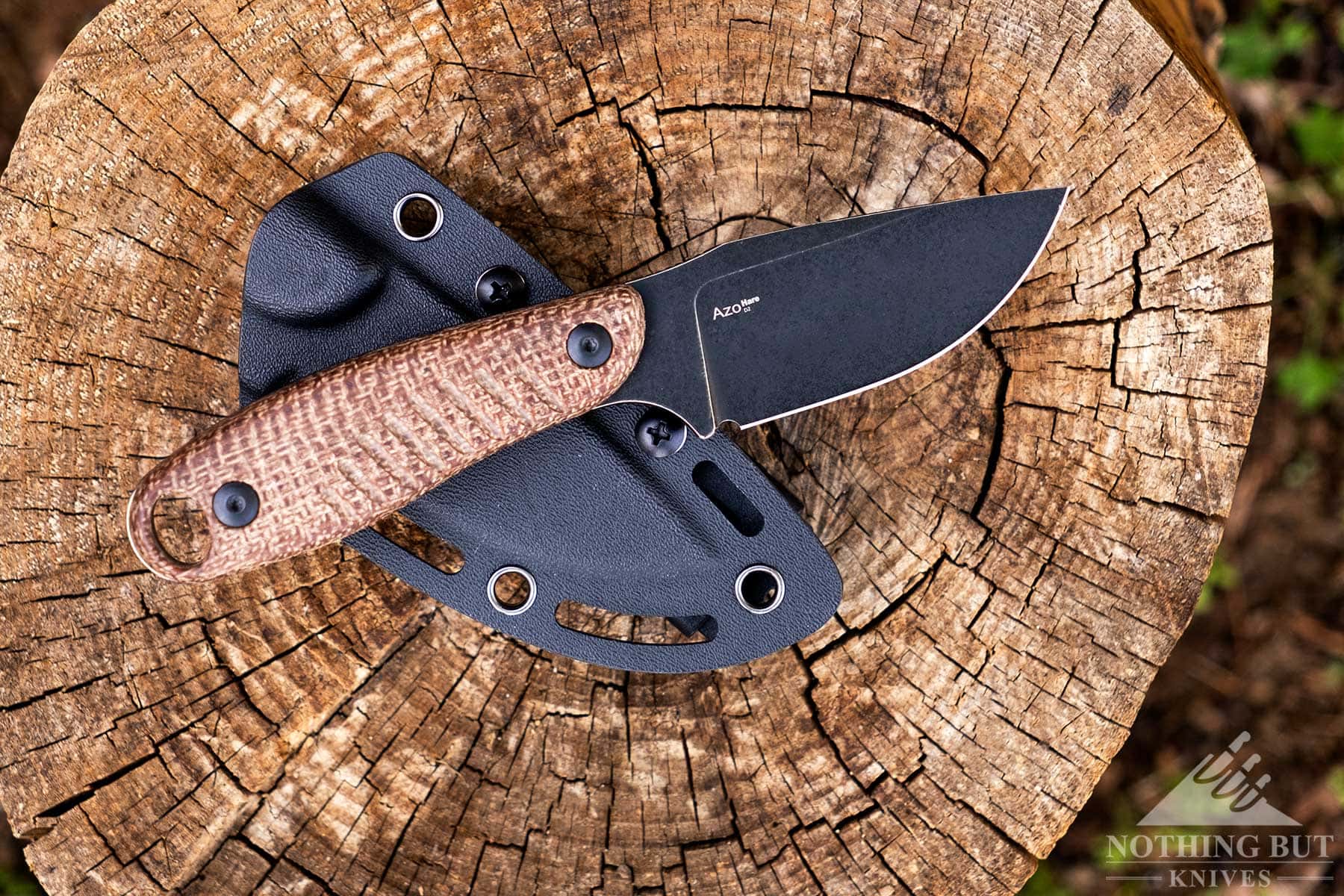
I wish that every version of this knife was made of Nitro V steel rather than D2 for the sake of making it easier to sharpen in the field and less likely to have issues with corrosion. But that is where my nitpicky complaints would end. This is an excellent design with a super grip friendly handle design and a tough, slicey blade. The sub $50 price point makes the Hare an impressive buy from a value standpoint.
The sheath is similar to the sheath that ships with the Smolt. It has a button lock release that makes it easy to remove from a belt quickly. It is also super versatile. It can be worn vertically or horizontally on a belt. It could also be carried on a backpack strap.
The Hare makes a good camping knife or a handy back-up survival fixed blade.
Baby
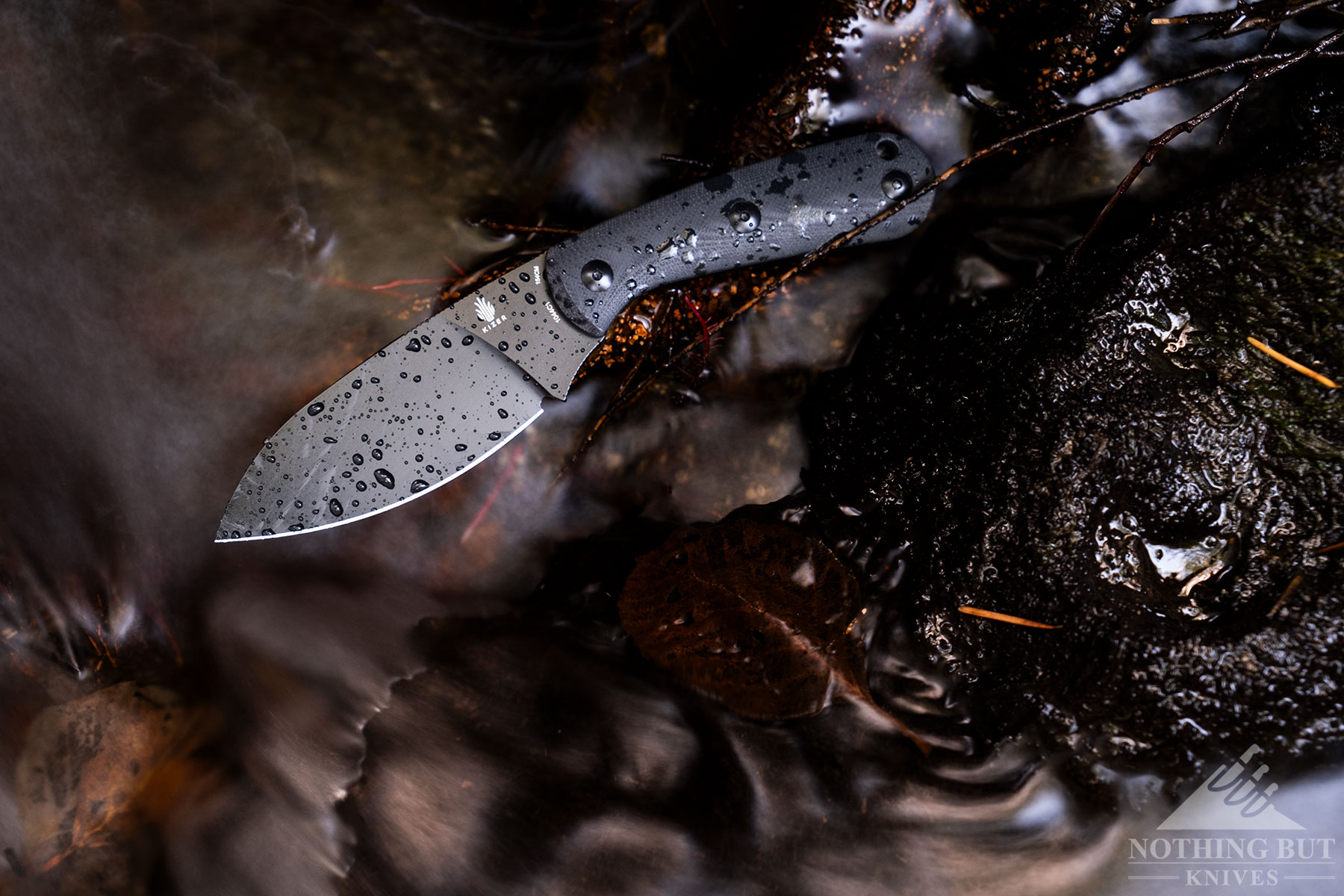
| Stand Out Features | Specifications |
|---|---|
| Great slicer, fixed-blade shilin cutter | 7.8” overall |
| Designed for EDC, general outdoor activity | 3.85” leaf-shape blade / 154CM steel |
| Rides on rotating clip | G10 handle scales |
| Designed by Azo Mai | Kydex sheath in taco or pancake style |
The Baby is a good example of the odd made functional. It’s a bit like a fixed blade shilin cutter with its negative edge plane and a handle that’s close to eggplant shaped.
It’s a slick EDC with high potential for outdoor and hunting work. Having a thin blade stock with a tall blade and a high flat grind makes the Baby an incredibly efficient slicer. It can take a little bit of time to get used to the particular shape, but once you do it presents an enormous amount of cutting power.
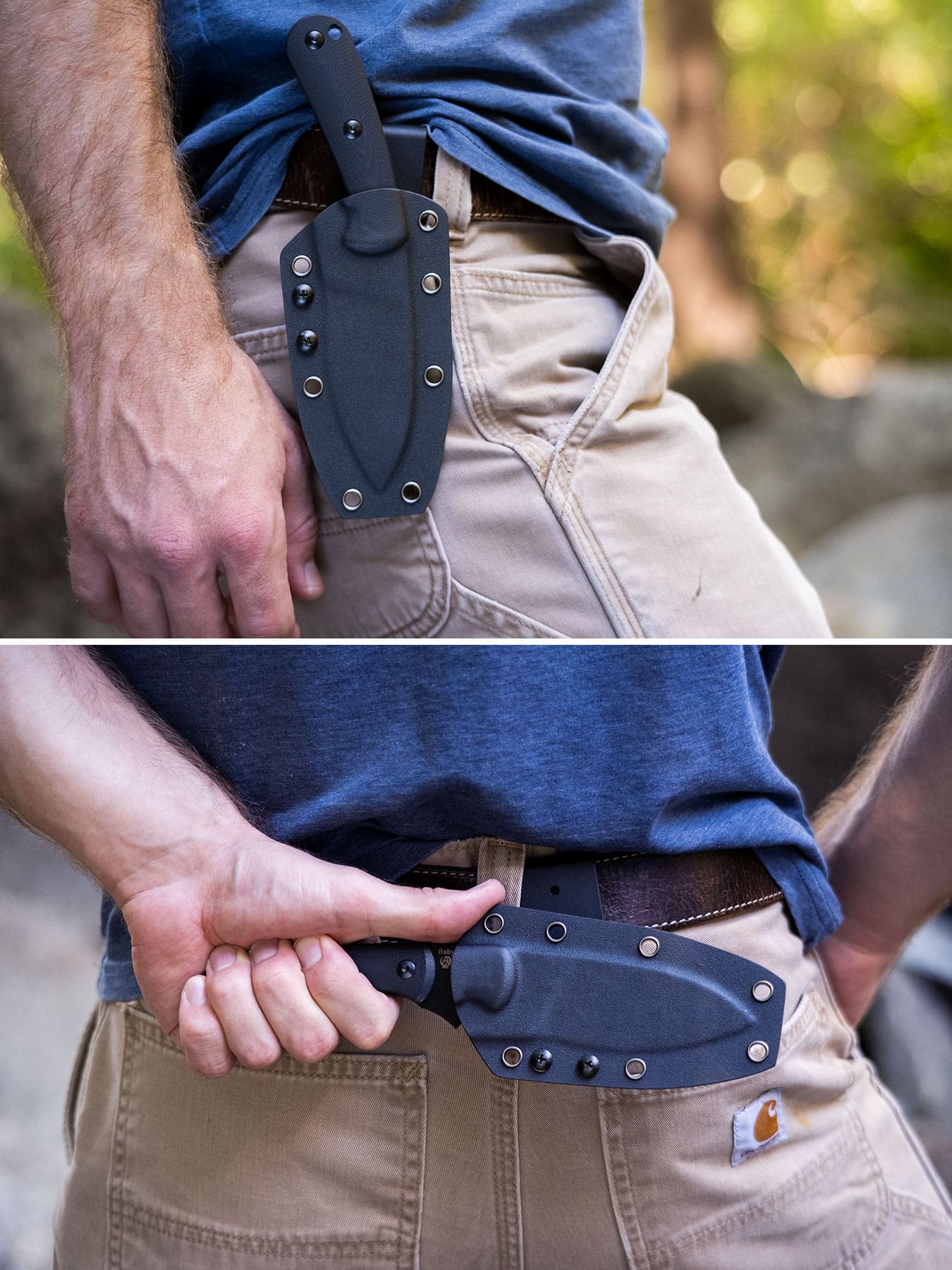
There are two versions with two different kinds of sheaths available. The materials are the same, though. The all-black version comes with a pancake-style sheath with a rotating clip system. The jade G10 version comes with a taco-style sheath with leather straps.
The rotating clip it sits on gives some nice versatility for carrying. In a standard vertical-carry position, drawing is more comfortable because you can adjust the angle of your draw, and it’s pretty good in an appendix carry, although it might drop too low for some body types.
Harpoon
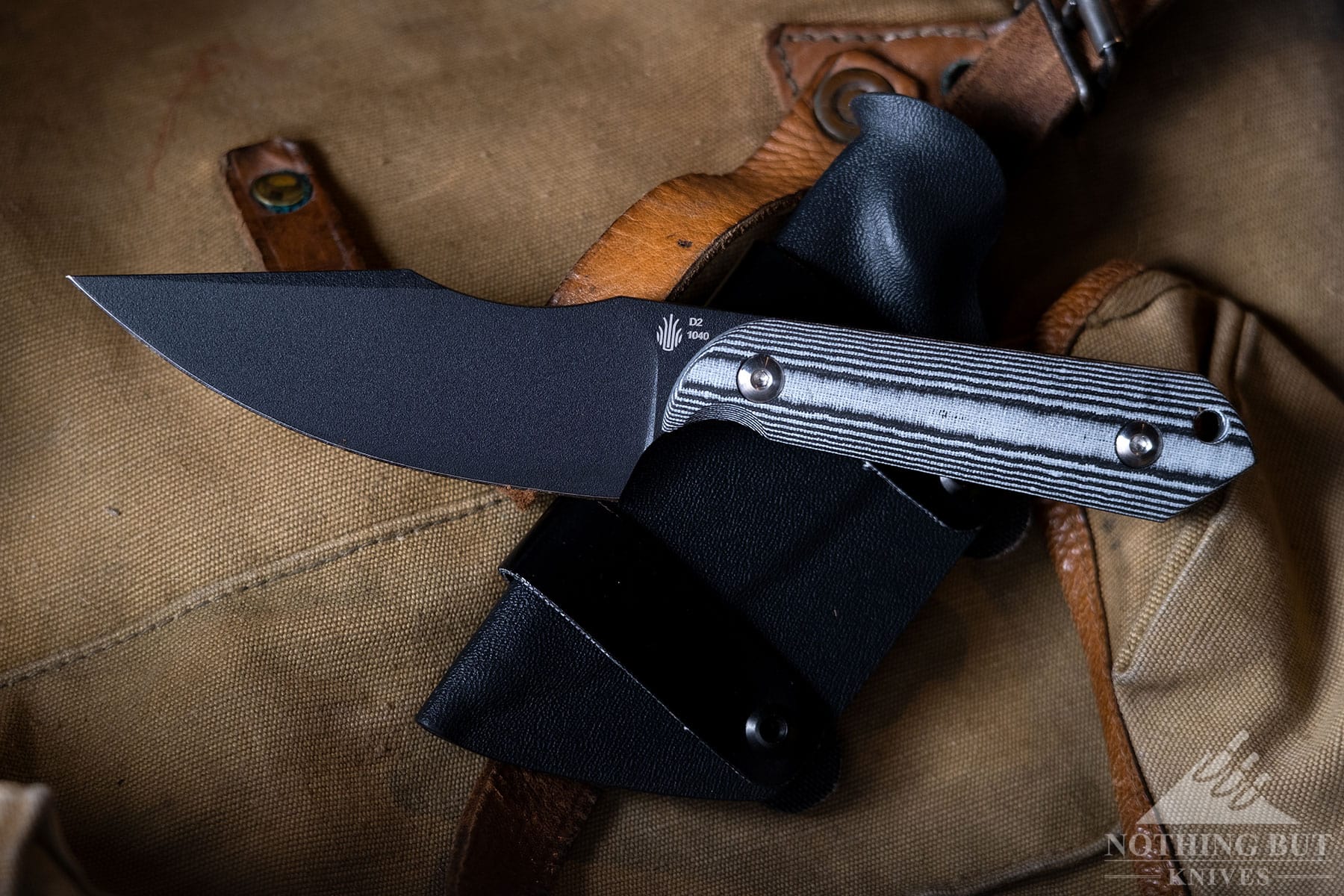
| Stand Out Features | Specifications |
|---|---|
| Compact for its size and has great carving ergos | 7.72” overall |
| Designed for general outdoor utility | 3.9” clip point blade / D2 steel |
| Rides on leather straps | Micarta handle scales |
| Designed by James Buckley | Taco-style kydex sheath |
Not just compact, the Harpoon also feels light for its size. It doesn’t beat the ounce-per-blade inch ratio but it’s well balanced, and the ergos have a way of putting the weight closer to your hand so it feels nimble.
That makes it a nice appendix carry option paired with the leather-strap carry system. It rides tight and draws easy, and the thumb ramp on the sheath has a good, easy curve that’s friendly with the thumb.
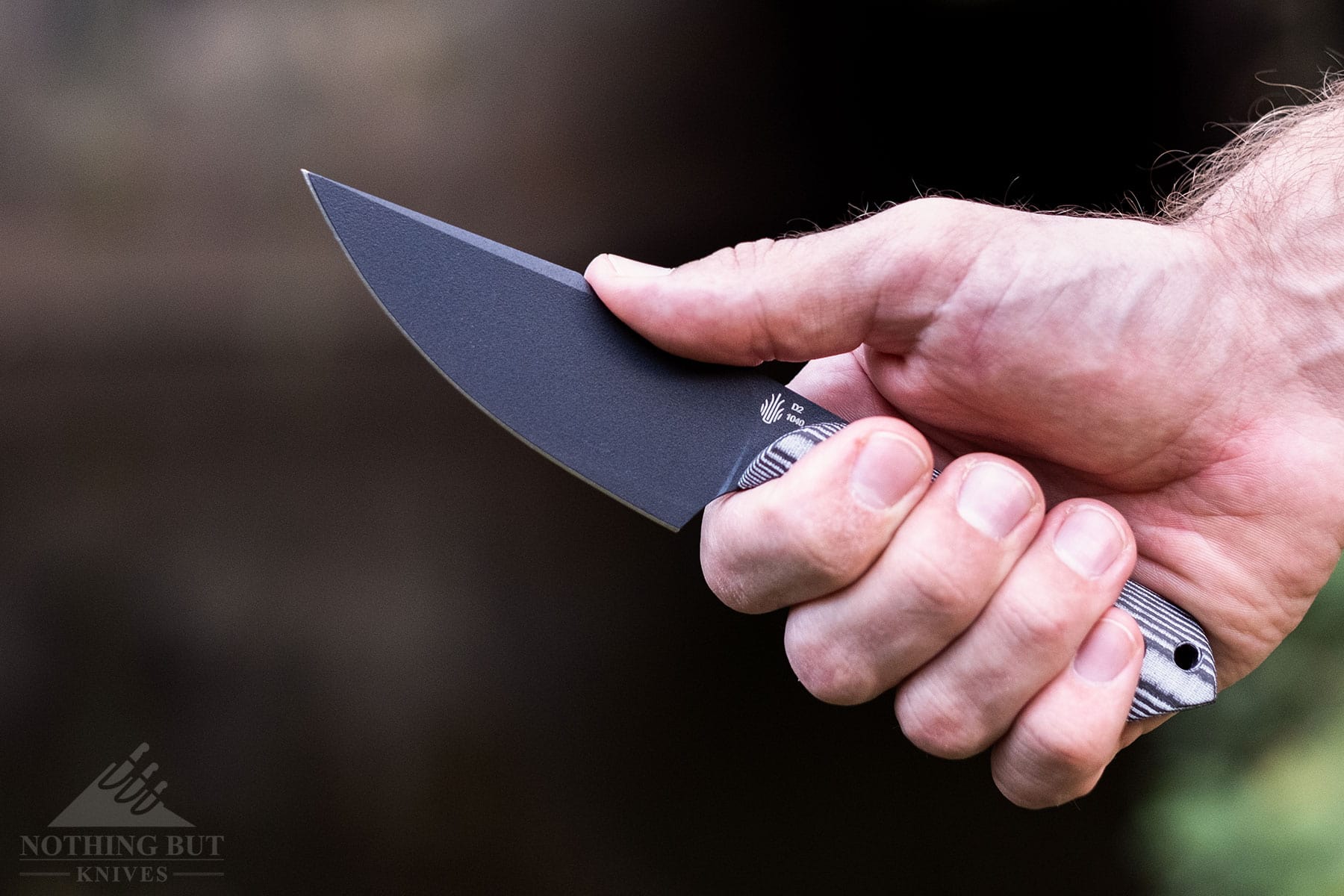
People like to talk about harpoon knife shapes as some kind of tactical-centric style, but the Kizer Harpoon is really just a fantastic outdoor utility knife. It’s thin so the edge bites pretty hard into wood, the handle is neutral so you about the same amount of comfort in several different grips, and the dip in the spine is placed really well so your grip really locks onto the knife for great control when you rest your thumb on it.
There’s a smaller version of this called the Harpoon Mini that comes with 3V steels. We haven’t gotten a hold of that one yet, but it’s in a similar material and size range to the Smolt, which we love, so it looks great from a distance.
We liked the Harppon enough to include it in our article on the Best Horizontal Carry Knives.
Small Fixed Blades
Smolt
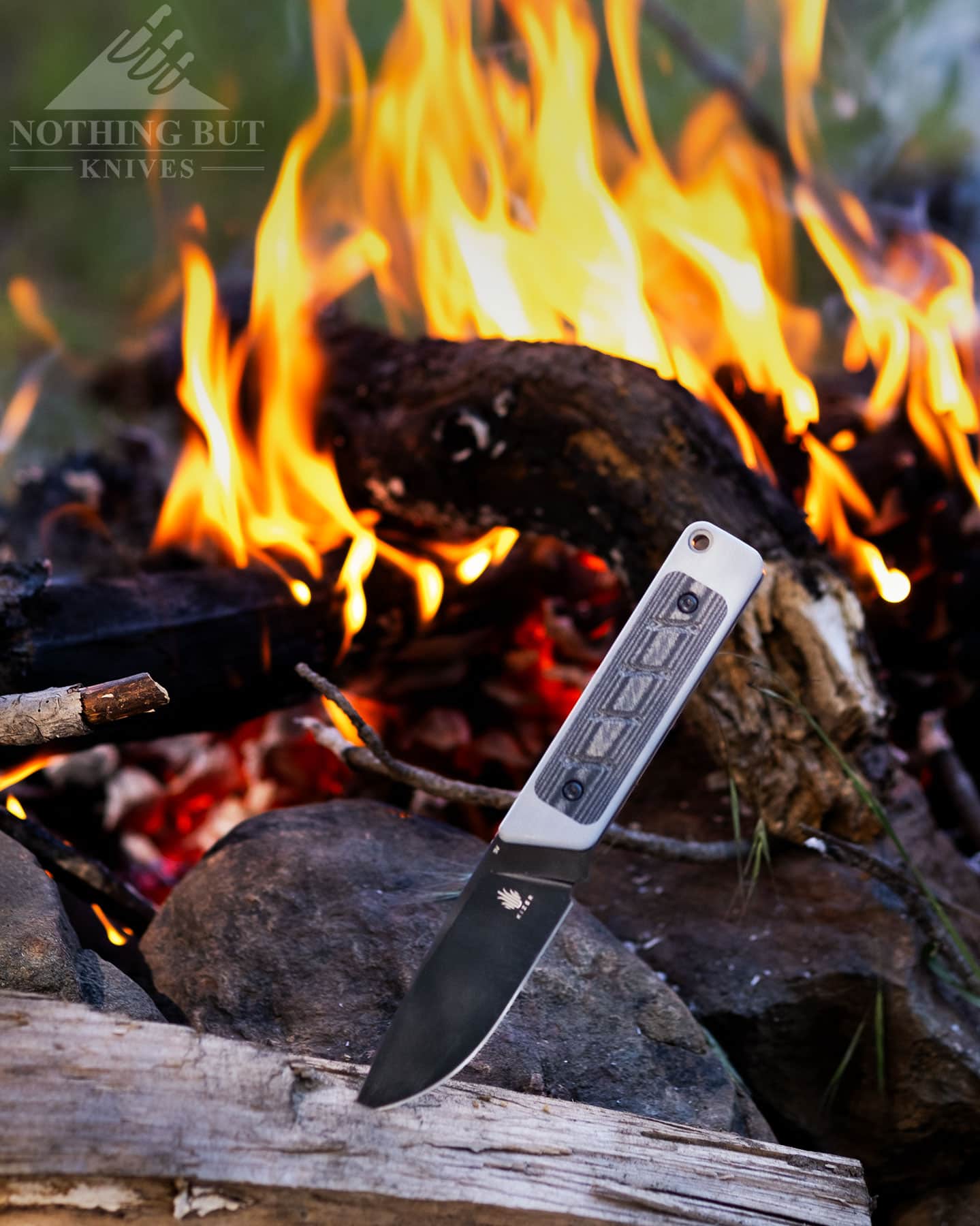
| Stand Out Features | Specifications |
|---|---|
| Made for EDC and general camping | 6.5” overall |
| Edge has aggressive bite | 2.9” drop point blade / 3V steel |
| Carries on button-lock clip | G10 handle w. Micarta inserts |
| Designed by Jonathan Styles | Pancake Kydex sheath |
There are a lot of surprising things about the Smolt. The 3V steel was one of the biggest for us, first because Kizer is using it at all, but it’s also an interesting choice for such a small fixed blade that seems geared for EDC. That’s something you normally see on larger survival and bushcraft knives
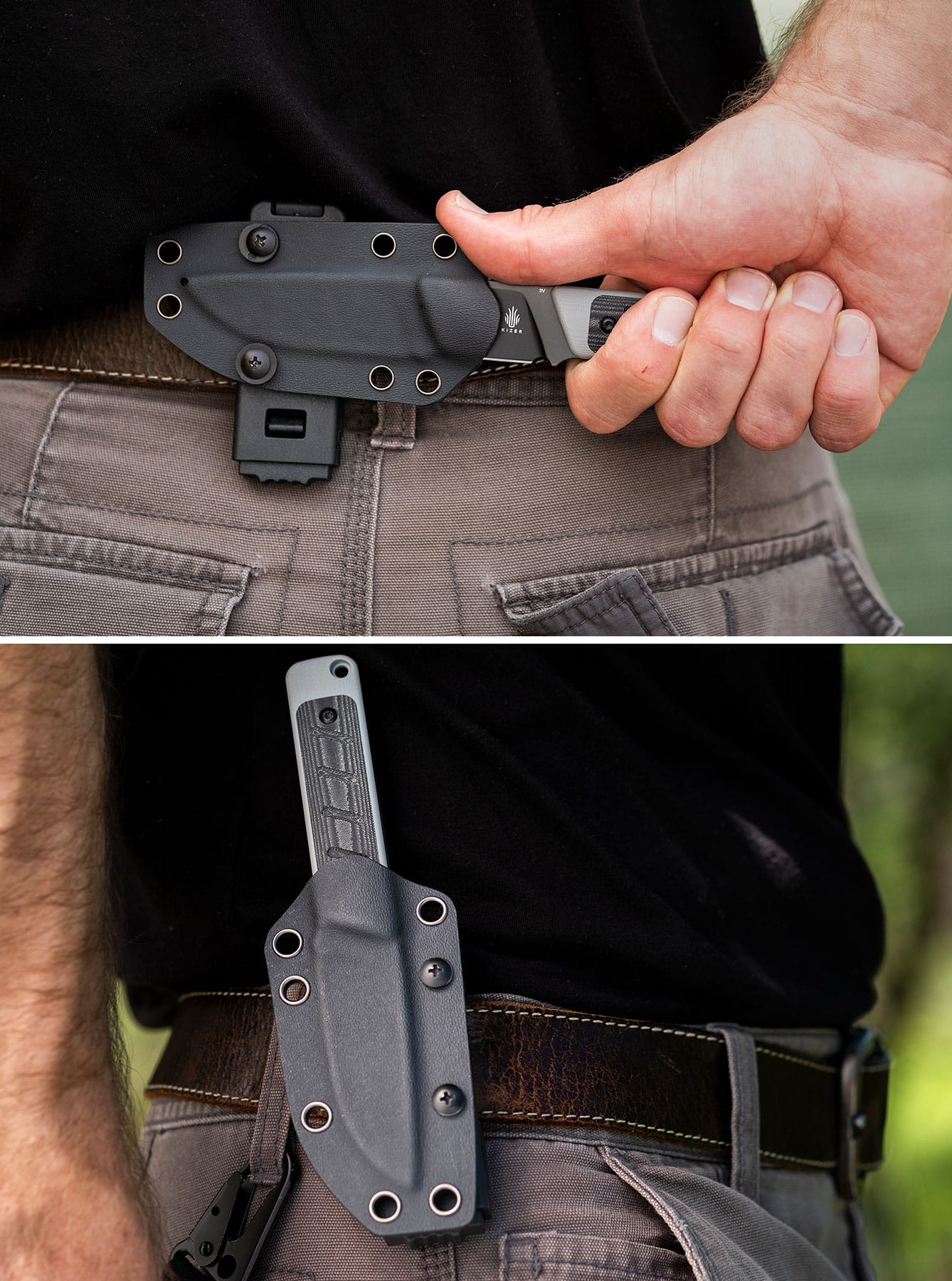
But this is small enough and slim enough to ride in the pocket and it cuts like a champ. The edge has a harsh bite that works well with wood, so it’s a good carving knife, and it handles EDC tasks like thread and boxes without a hitch.
Its main downside is that it doesn’t always feel great to cut with. The boxy handle starts to bite a little on hard cuts, and of course if you have larger hands you might find your pinky slipping off the end of the handle.
This knife really stands out as one that would benefit from a leather sheath option. I would like to see a friendly one with out a belt loop similar to the BPS Knives Finn Lite
You can check out our Smolt photo tour if you’d like to see more images of this handy little EDC.
Bowtie
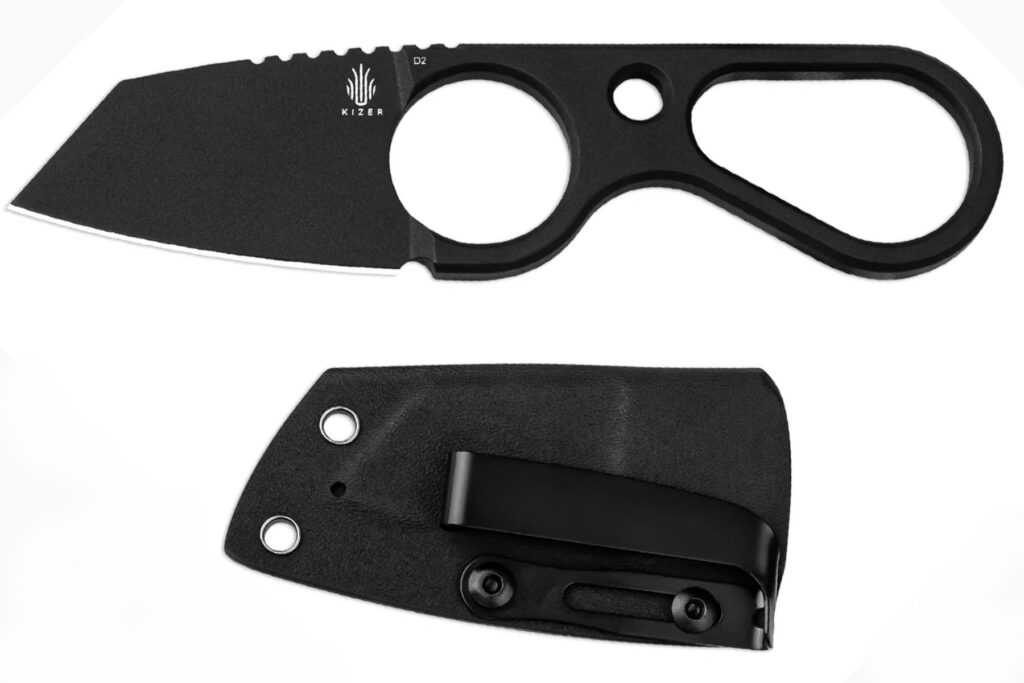
| Stand Out Features | Specifications |
|---|---|
| Made for EDC and utility | 5.83” overall |
| Designed for lightweight carry | D2 reverse tanto blade |
| Carries on G-style clip or neck | Skeletonized handle |
| Designed by Henning Marxen | Pancake style Kydex sheath |
It’s just about as barebones as you can get with a knife with a skeletonized handle and a wharncliffe blade. It’s a utility neck knife, basically.
The handle isn’t just skeletonized, though, it’s also conveniently finger-sized in the top and bottom so you can hold the Bowtie sort of like partial brass knuckles (it is nowhere near ideal for the same use case as brass knuckles, though).
As far as comfort goes, it’s not the most impressive option, but for a skeletonized fixed blade it isn’t bad.
The taco style sheath comes with Kizer’s G-clip so you can slip it on a belt easily enough. It really feels like it was meant for the neck, though.
Scuttler
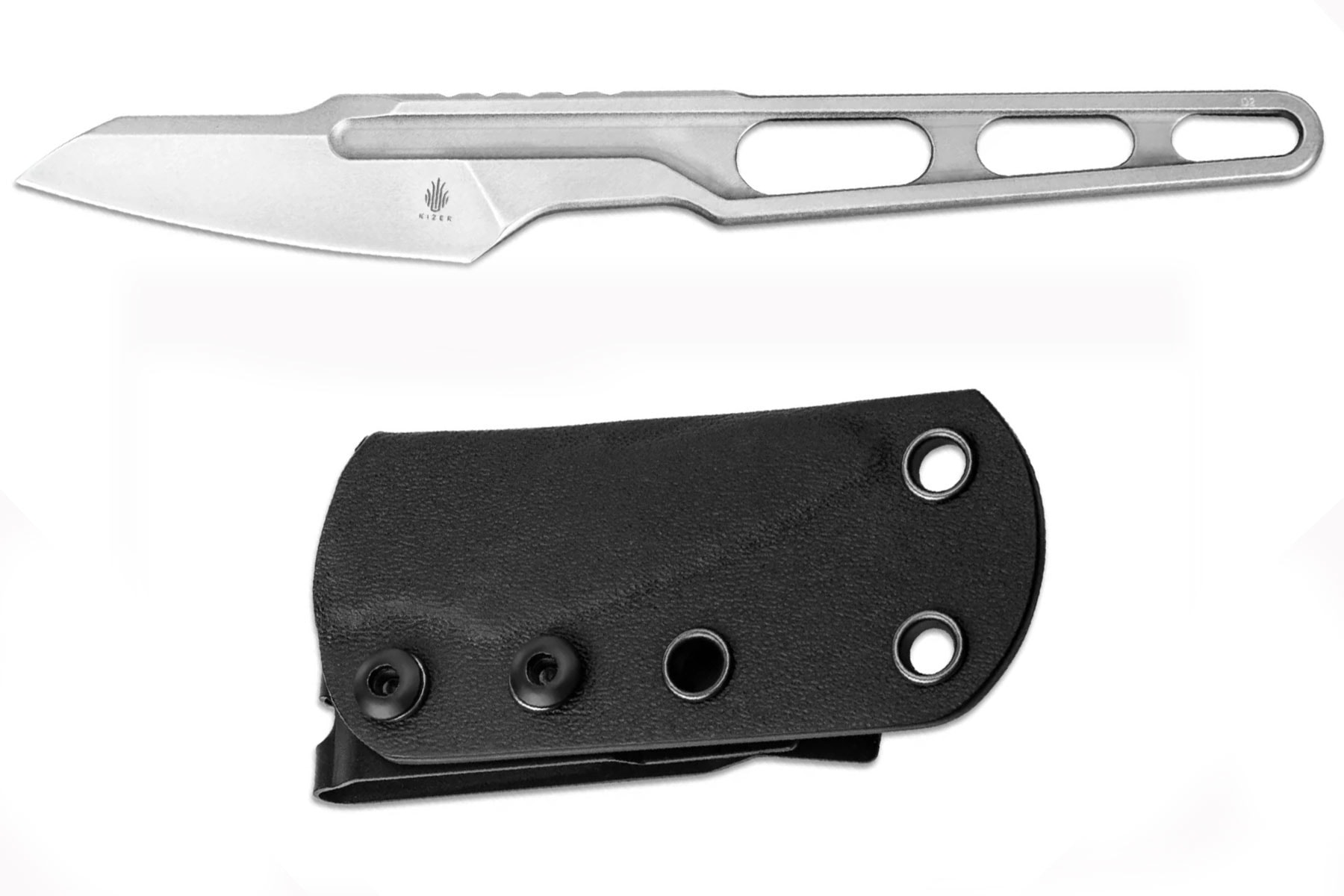
| Stand Out Features | Specifications |
|---|---|
| Small and lightweight | 5.78” overall |
| Made for EDC and Utility | 2.05” modified sheepsfoot blade / D2 steel |
| Carries on clip or neck | Skeletonized handle |
| Designed by Maciej Torbe | Taco-style Kydex sheath |
It’s super small and super light, and primed for wearing as a neck knife or carrying in your pocket.
With hard lines turned soft in a comfortably modern way that’s typical of Torbe designs, the Scuttler manages to give almost four inches of handle while staying under six inches overall.
And while it only has about two inches of cutting edge, the clip point blade gives it a utility-knife feel to it. That’s probably the best way to think of the Scuttler. It’s a pocket exacto blade with a skeletonized handle and D2 steel.
It’s a good setup for fixed-blade EDC because the clip on the sheath is a much friendlier pocket-clip style as opposed to the Tek Lok or G-clips on most of the others.
For such a small knife, it has a lot of different spots that become helpful in different grips. It just has a lot going on in such a small space.
The Cobbler
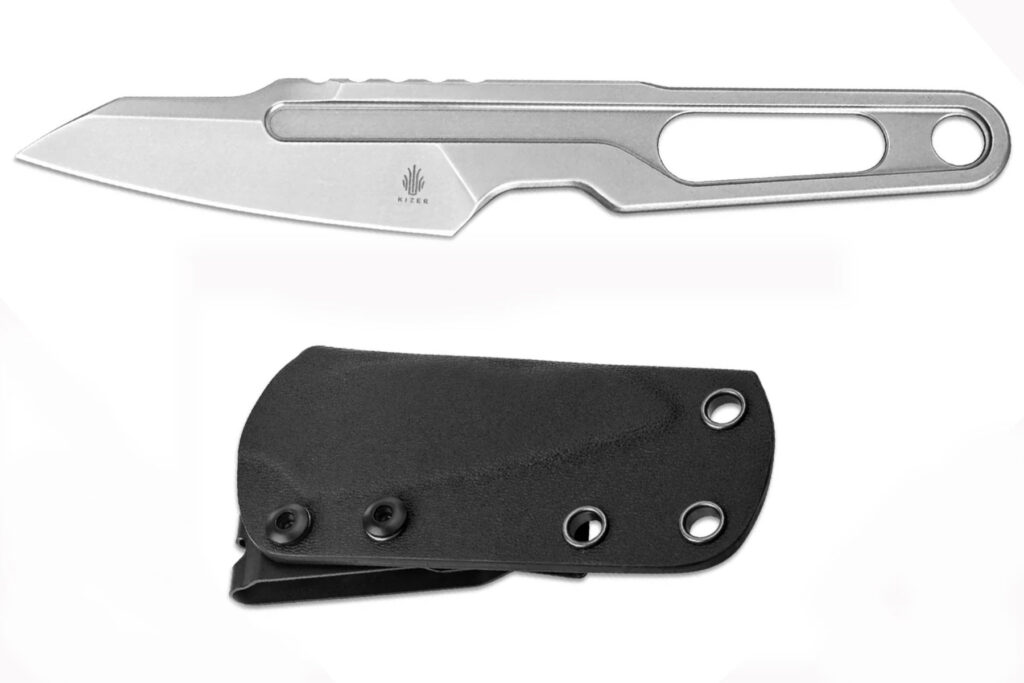
| Stand Out Features | Specifications |
|---|---|
| Larger version of the Scuttler | 6.66” overall length |
| EDC and utility | 2.89” modified sheepsfoot blade / D2 steel |
| Carries on clip or neck | Skeletonized handle |
| Designed by Maciej Torbe | Taco-style Kydex sheath |
Same deal as the Scuttler: Angular design with a skeletonized handle that has a lot of helpful griping spots, and it comes in a taco-style sheath with a large pocket clip.
The only differences are the dimensions. It’s longer and a little thicker, so it’ll feel more comfortable, and will probably be easier to draw for most people. The actual carrying aspect might be a little more awkward in some places since there’s more handle sticking out of the sheath, though.
Still, it’s a small knife with a ton of utility.
The Groom
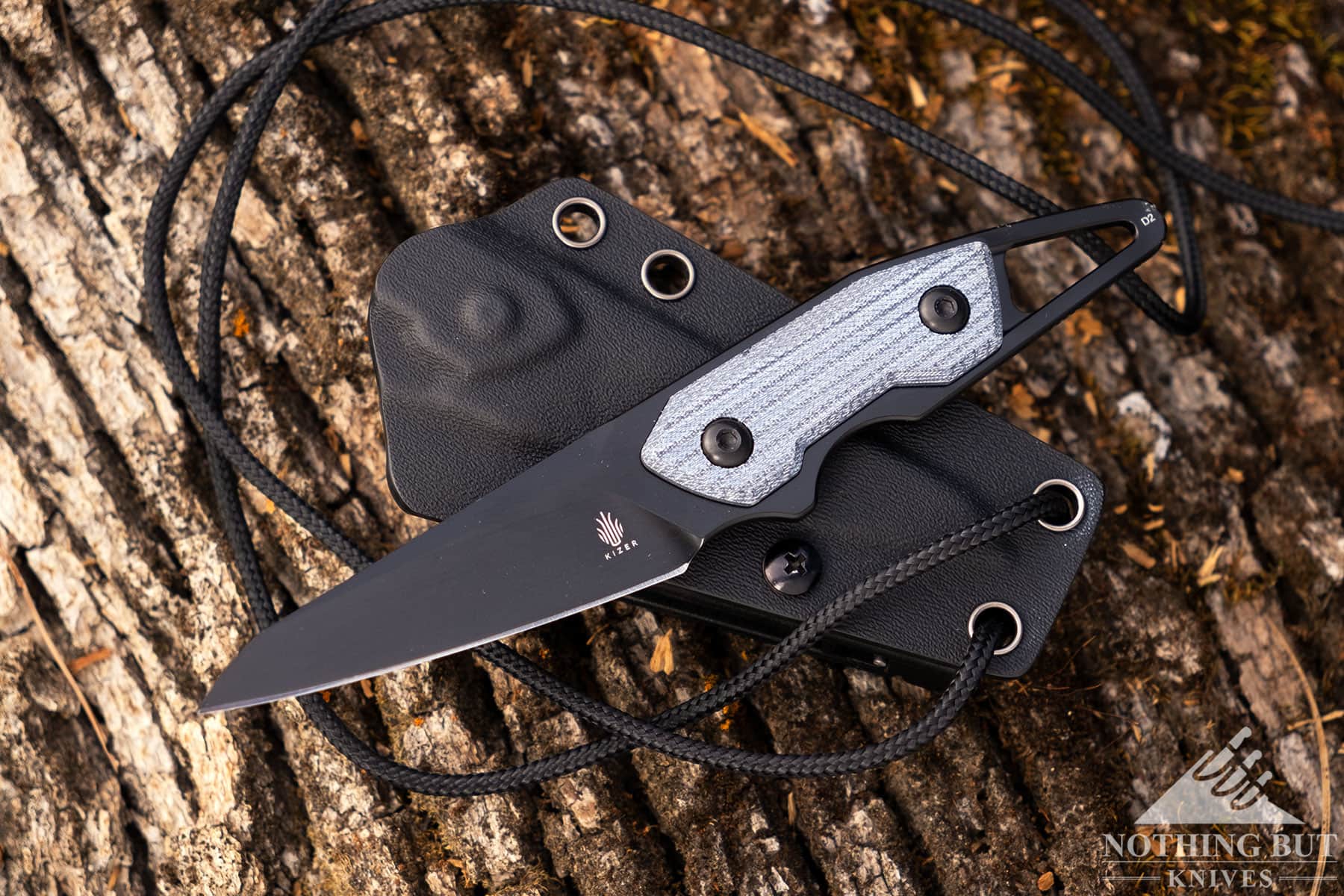
| Stand Out Features | Specifications |
|---|---|
| Slim, sharp, and lightweight | 6.74” overall length |
| Designed for EDC | 3.08” reverse tanto blade / D2 steel |
| Carries on button-lock clasp or neck | Handle scales in Micarta, carbon fiber, or Ultem |
| Designed by Maciej Torbe | Pancake-style Kydex sheath |
The Groom is in the super-lightweight category. It’s a good neck knife option because of that, but it’s slim enough to just take off the clip and slip it into your pocket (now if only it had a taco-style sheath like the Scuttler).
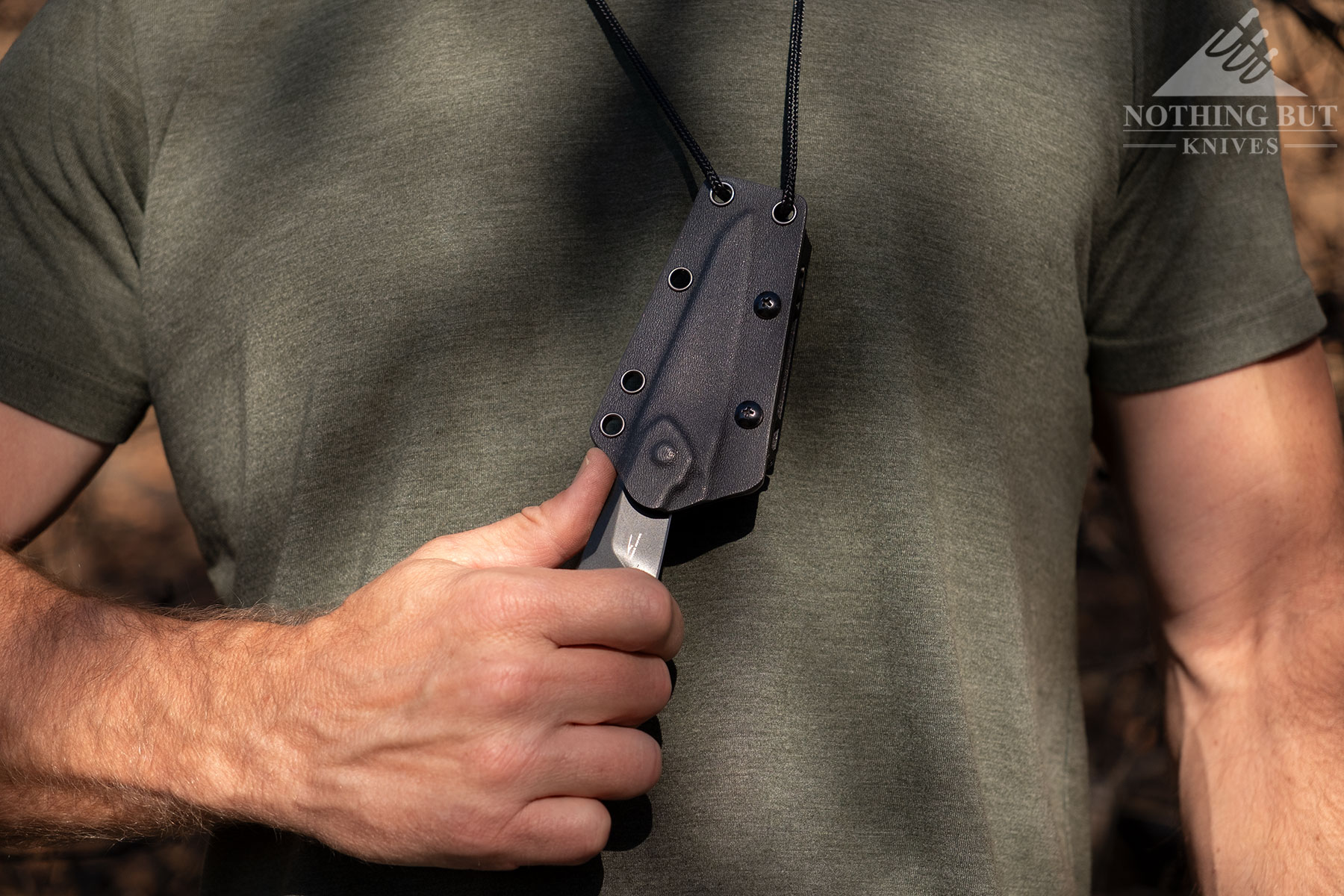
One little issue is that the finger choil isn’t quite big enough. It puts the index finger awfully close to the heel of the cutting edge, so sometimes it feels little dangerous tighten up on on the grip.
The solution is to mostly use it in a pinch grip, or with the index finger pressed along the spine in a sort of skinning grip. That works out great. The blade shape lends itself to utility tasks, and it’s light enough to be easy to hold in pretty much any position.
Deckhand
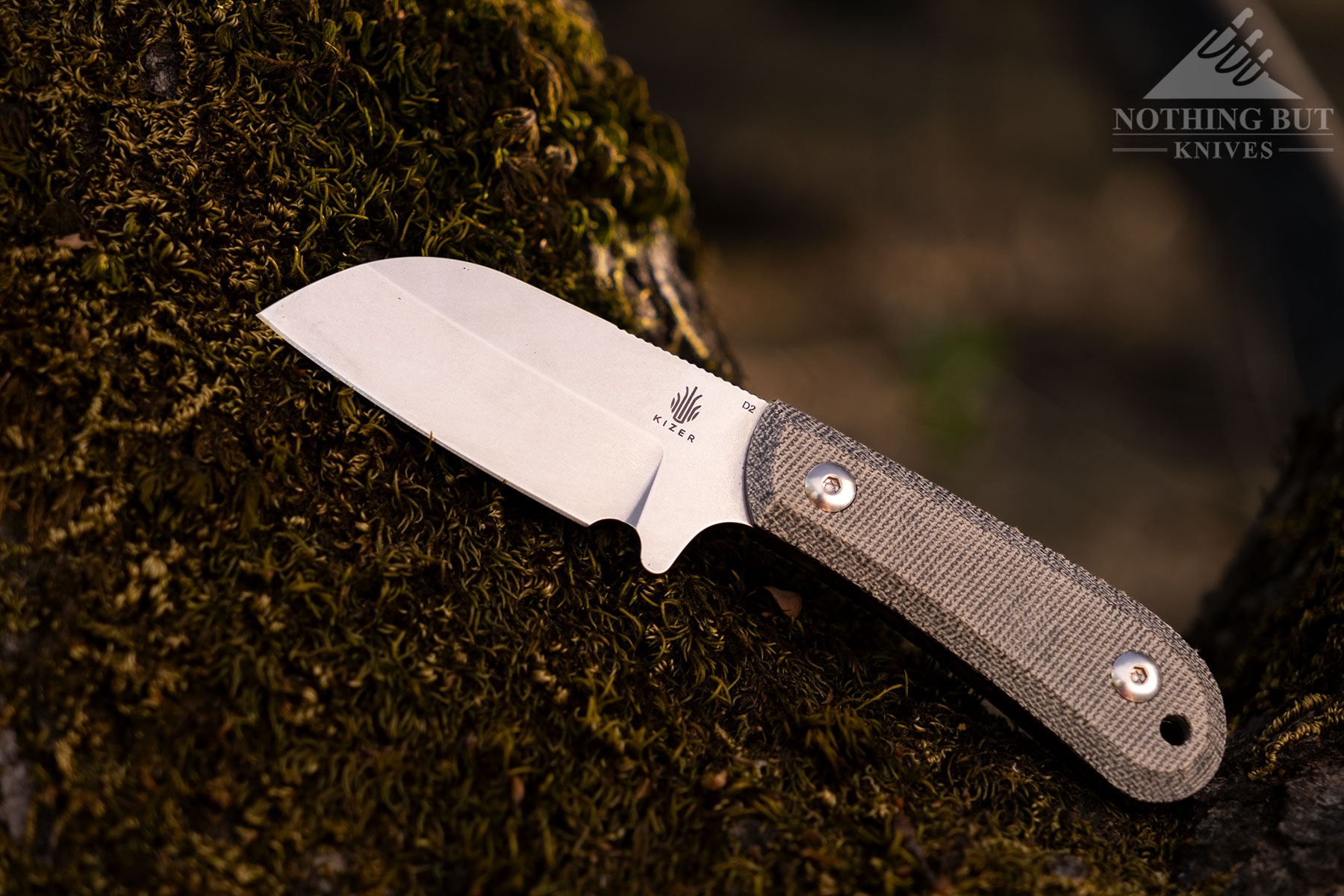
| Stand Out Features | Specifications |
|---|---|
| Small, easy to carry, comfortable grip | 6.34” overall |
| Designed for compact EDC | 2.95” sheepsfoot blade / D2 steel |
| Carries on G-style clip or neck | Micarta handle scales |
| Designed by Tyler Barnes | Taco-style sheath w/ G-style clip |
Our first reaction to the Deckhand was pure excitement that Kizer had come out with a fixed-blade version of the Sheepdog. Closer inspection showed that the design is a ways from that folder, though.
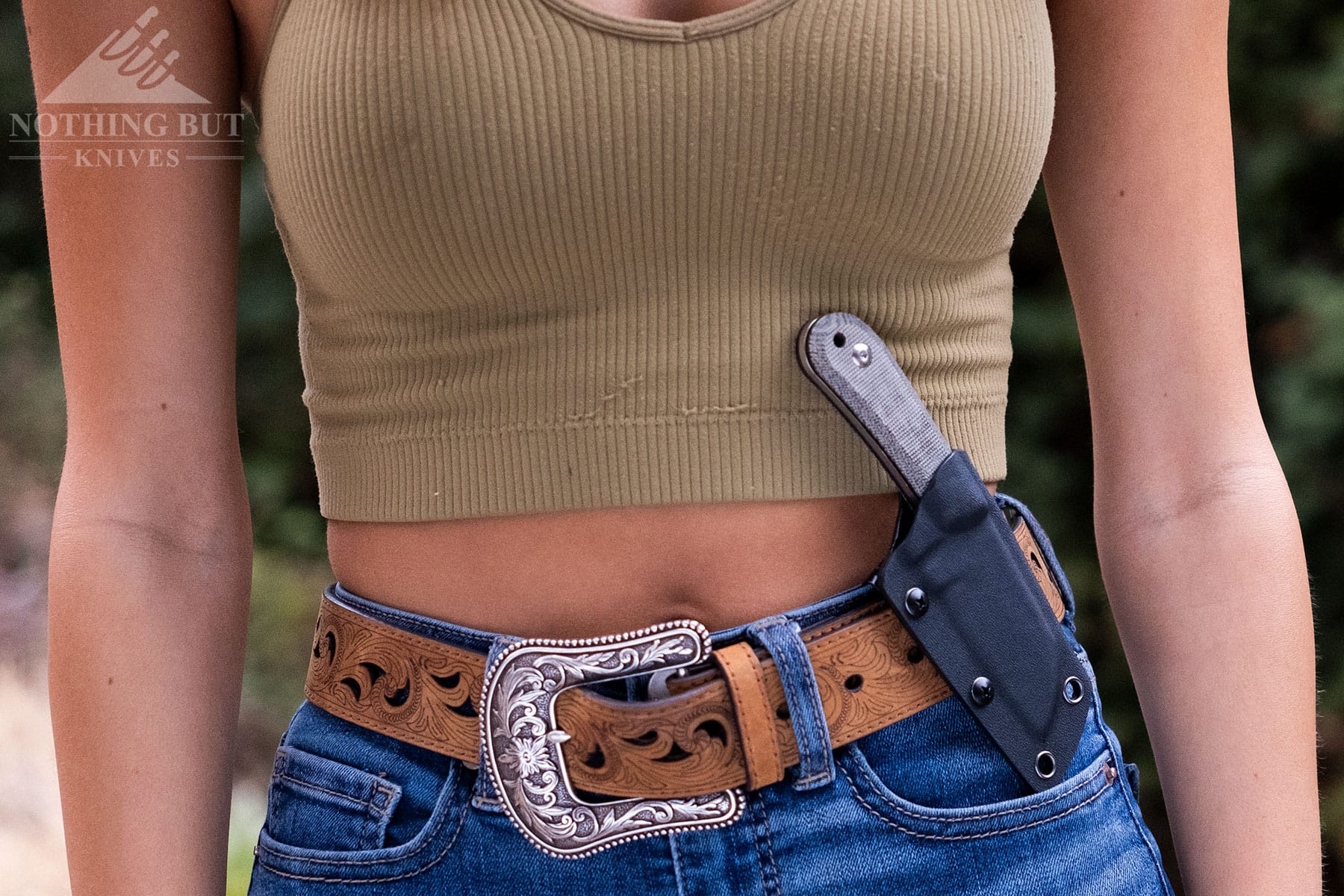
Mainly because the handle is a lot simpler. They opted for straighter, more neutral lines that open up grip possibilities a lot. They also keep the cutting edge completely straight, making it a true sheepsfoot blade that’s exceptionally good at cutting rope in spite of the shortness of the blade.
The sheath is simple enough, but it comes with an open G-style clip that you can slip right onto your belt (a lot faster than you’ll be able to take it off).
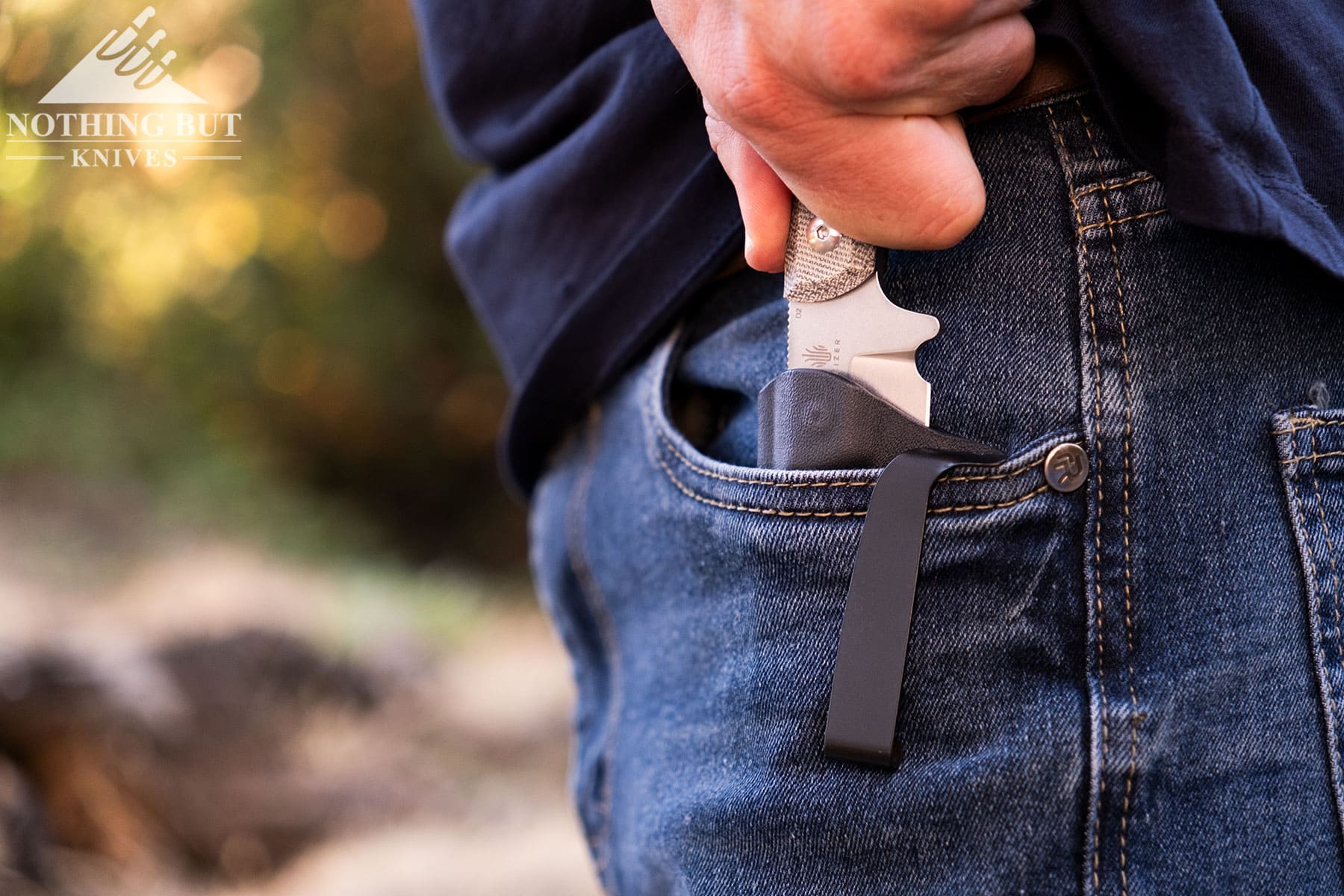
One quick warning: the name and blade shape make the design of this knife make it seem attractive for maritime use, but D2 isn’t exactly water friendly being only partially stainless. Take this knife wherever you want, but if it’s on the water you’ll need to be extra vigilant about corrosion.
The Deckhand can be carried in a variety of ways, but we preferred it as a neck knife or pocket EDC.
Variable
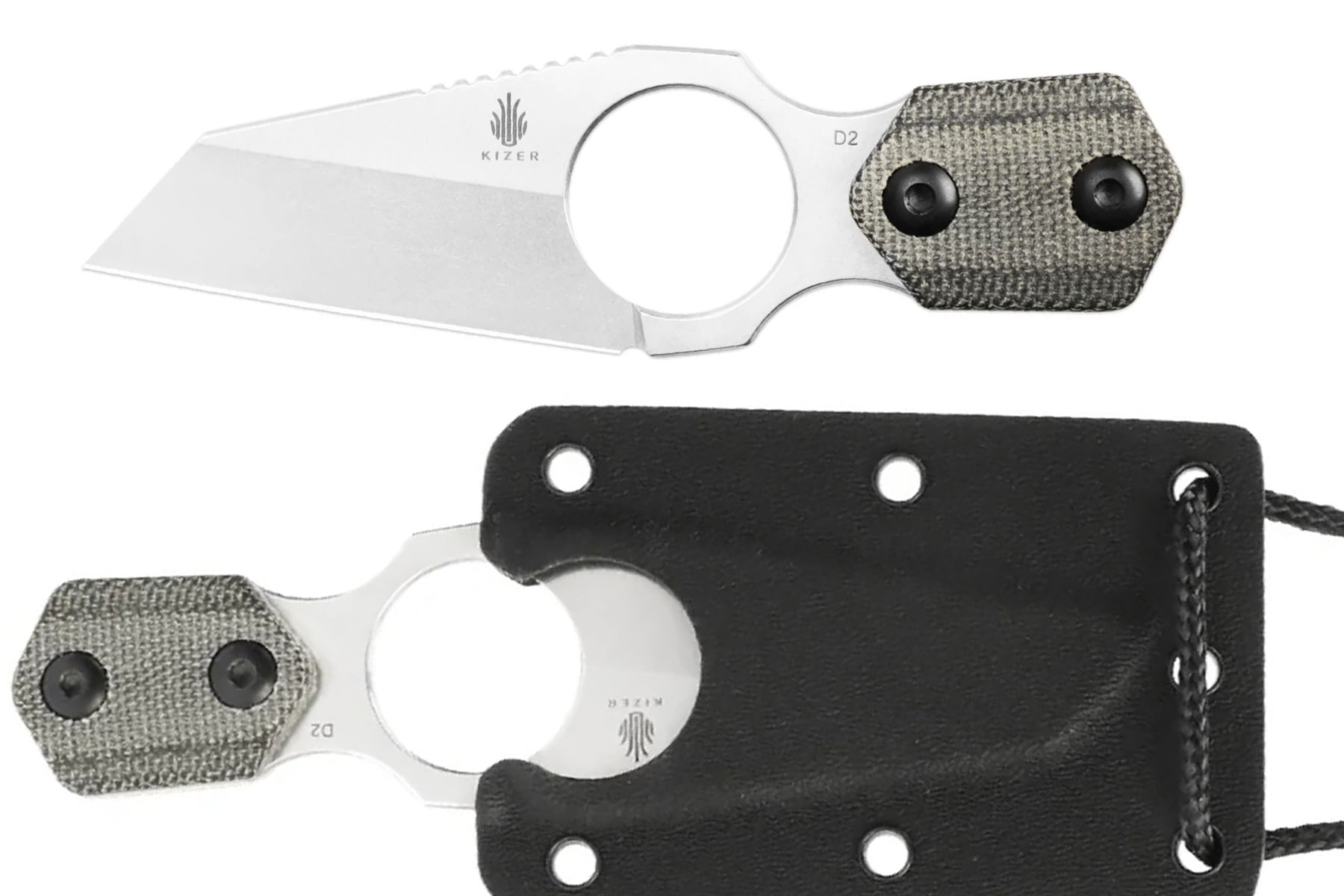
Variable
| Stand Out Features | Specifications |
|---|---|
| Compact with high-utility blade | 4.84” overall |
| Designed for EDC and utility | 3.43” blade / D2 or 154CM steel |
| Neck knife carry | Micarta or carbon fiber handle scales |
| Designed by Dirk Pinkerton | Pancake-style kydex sheath |
The Variable looks like a designer challenge to see how little handle they could get away with putting on a knife. With an overall length of five inches, the actual handle part of it is maybe an inch.
The result is a barebones neck knife that you can fit pretty much anywhere. Using it might be a little awkward sometimes, but the design intent is to be easy to carry. It follows the design philosophy that the best knife for any situation is the one you have on you.
This is available in a couple different variations: the blade comes in wharncliffe or a claw style, while the steel options are D2 or 154CM. The D2 version is only available in a wharncleffe blade shape currently, though.
Rocker
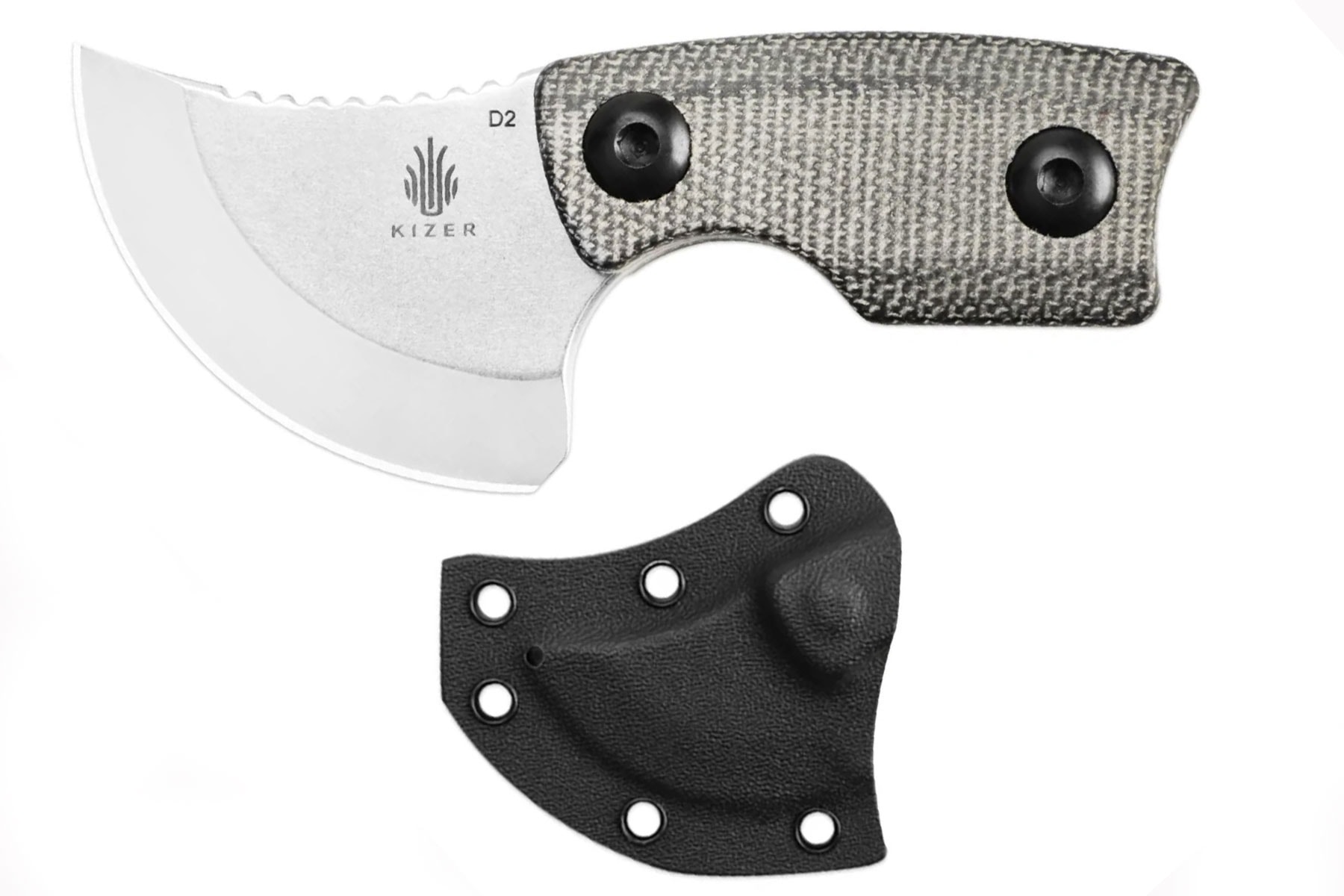
| Stand Out Features | Specifications |
|---|---|
| Extremely compact | 3.35” overall |
| Designed for EDC | 1.38” upswept blade / D2 steel |
| Neck-knife carry | Micarta scales |
| Designed by Dirk Pinkerton | Pancake-style Kydex sheath |
The Rocker shows just how much cutting edge you can fit into a small space. On a blade that measures less than 1.5 inches in length; it might border on two inches of actual cutting length.
But it’s tiny. It does a lot with the material it has: gives you some decent room for your index finger, and a bit of curvy grip with Micarta scales to brace up on with the pad of your hand. But the purpose of the knife is to be tiny with a lot of edge (something the designer Dirk Pinkerton enjoys playing around with).
A lot of people would call this a back up knife. It all depends on what you think you’ll need to cut, but if nothing else, it’s a low-investment carry in terms of weight and size.
Muskrat
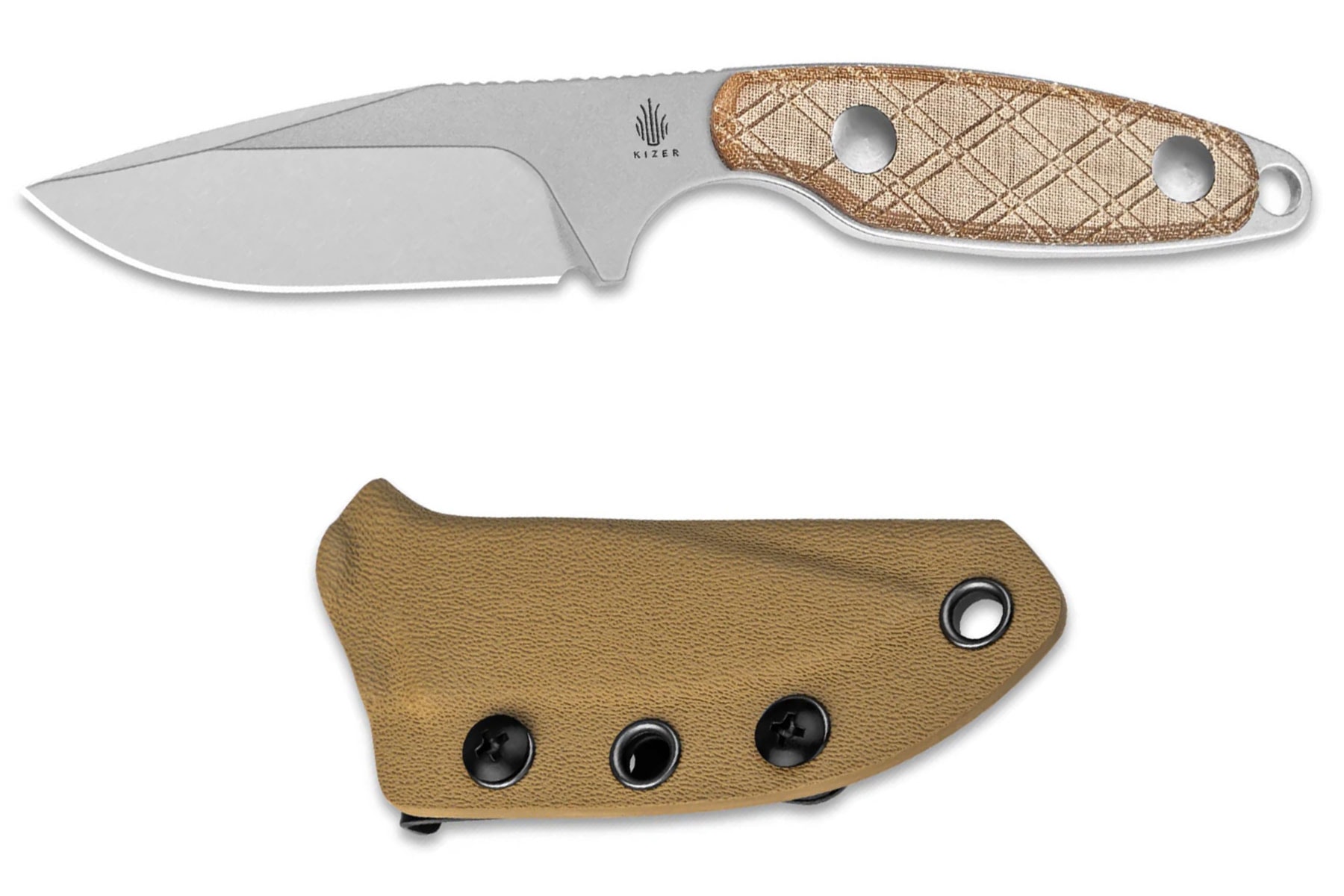
| Stand Out Features | Specifications |
|---|---|
| Small and comfy | 6.1” overall |
| Designed for EDC and camping | 3.15” clip point blade / D2 or 154CM steel |
| Carries on G-style clip | G10 or Micarta scales |
| Designed by Derek Sharon | Taco-style Kydex sheath |
Let’s call this Kizer’s answer to the Bradford Guardian 3. There are key differences like the handle scales being more spars on the Muskrat, the protruding bolster between the finger choil and the heel of the edge, and it’s a little smaller. But it’s a good point of comparison.
So you have all the nice parts of a small-ish knife that hangs near the edge of becoming a mid-sized knife: it’s easy to carry, has a good full grip, and a blade size in the goldilocks zone of usability where it works well for almost everything before becoming unwieldy.
Currently there are two versions: The D2 steel version with a blacked out blade and green G10 scales, or the 154CM steel version with a stonewash finish and Micarta scales. Either way you’re packing this thing on a G-style clip that hooks pretty easily onto the belt and a Kydex sheath that’s compatible with most aftermarket clip and belt solutions.
The Carry Options of Kizer Fixed Blades
They use a healthy range of different clips and straps for getting a knife to stay attached to your belt or MOLLE system. Here’s a quick run-down of what we’ve encountered in their line up and mechanics and characteristics of each.
G-clip
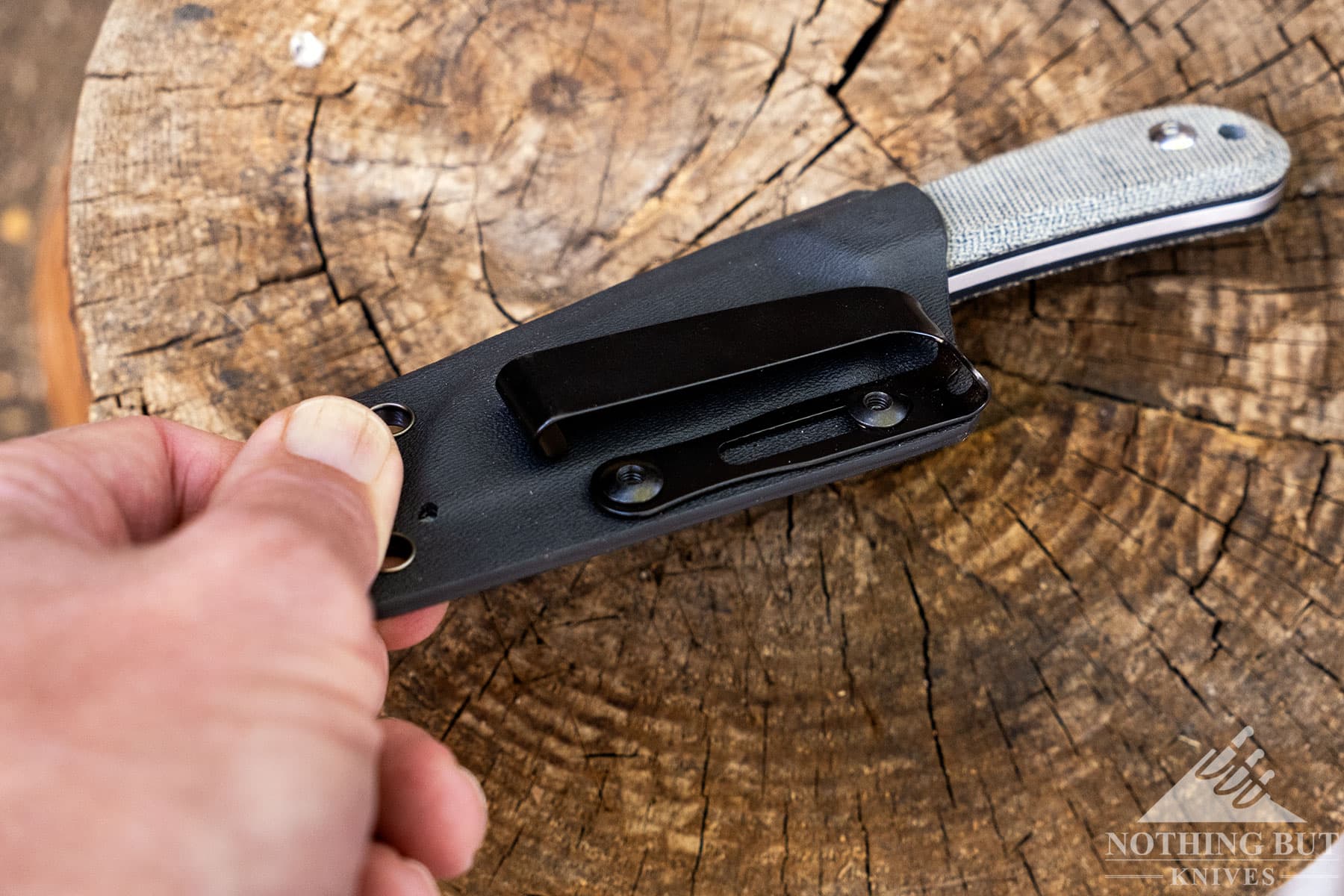
- Easy to attach
- Loose grip
This is an open spring-style clip that has a hook shape on the bottom. There are no buttons or fasteners, it just slips over the belt and then it’s locked in. It seems to be primarily designed for carrying on a belt in a conventional vertical position. The grip is pretty loose, so not ideal for horizontal carry. In a pinch it can be used as a pocket clip as well, although we wouldn’t recommend using it that way for very long or every day as it will bend the clip out of shape.
Rotating Clip
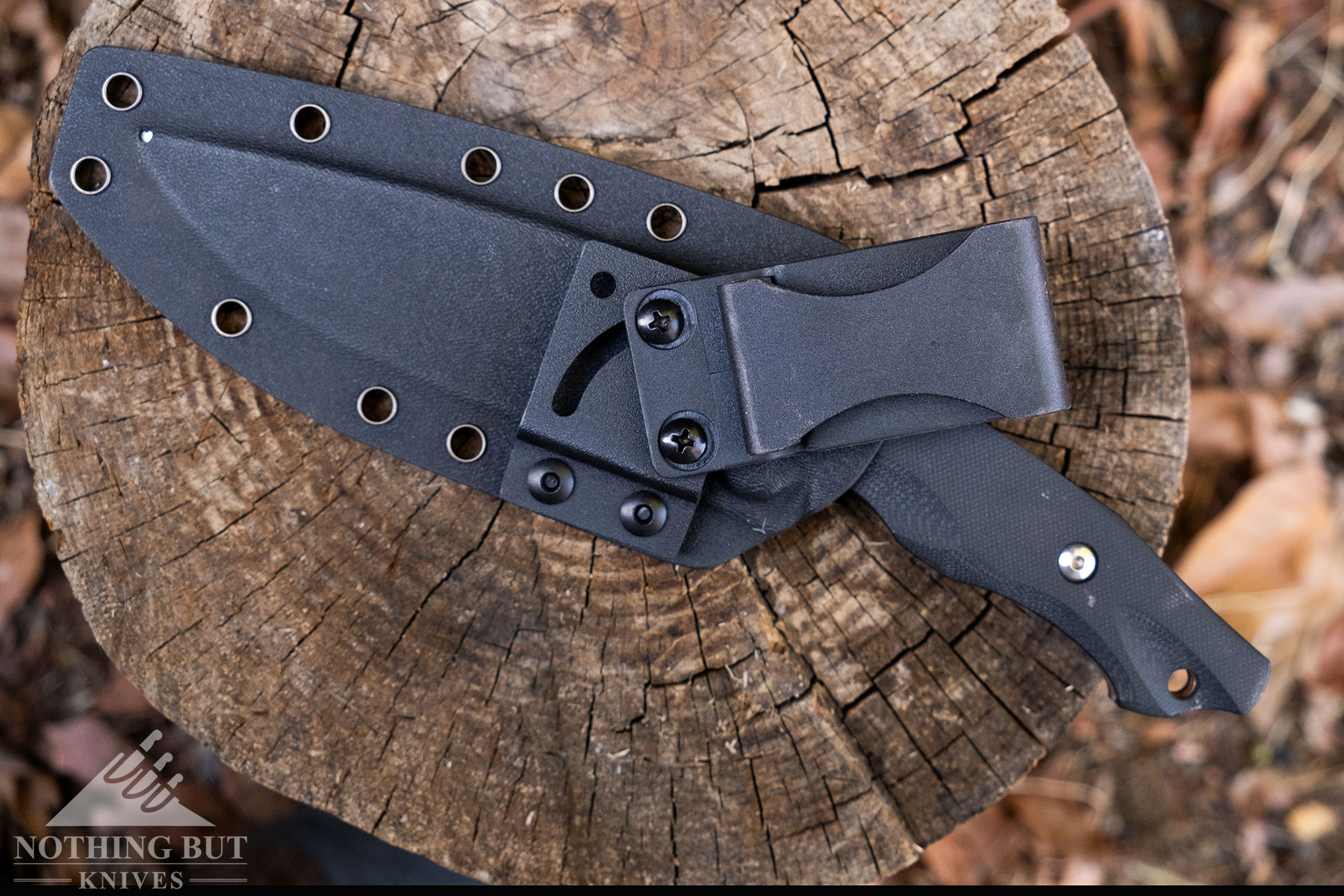
- Versatile carry positions
- Easy to adjust
It’s a G-style clip that has a quarter-circle track in the mounting plate so you can adjust the angle the knife rides at without having to take anything apart. It’s great if you like to wear your knife in different places depending on where or how you’re traveling. It’s also a great solution to the discomfort that can come from drawing in a vertical position.
Leather Straps
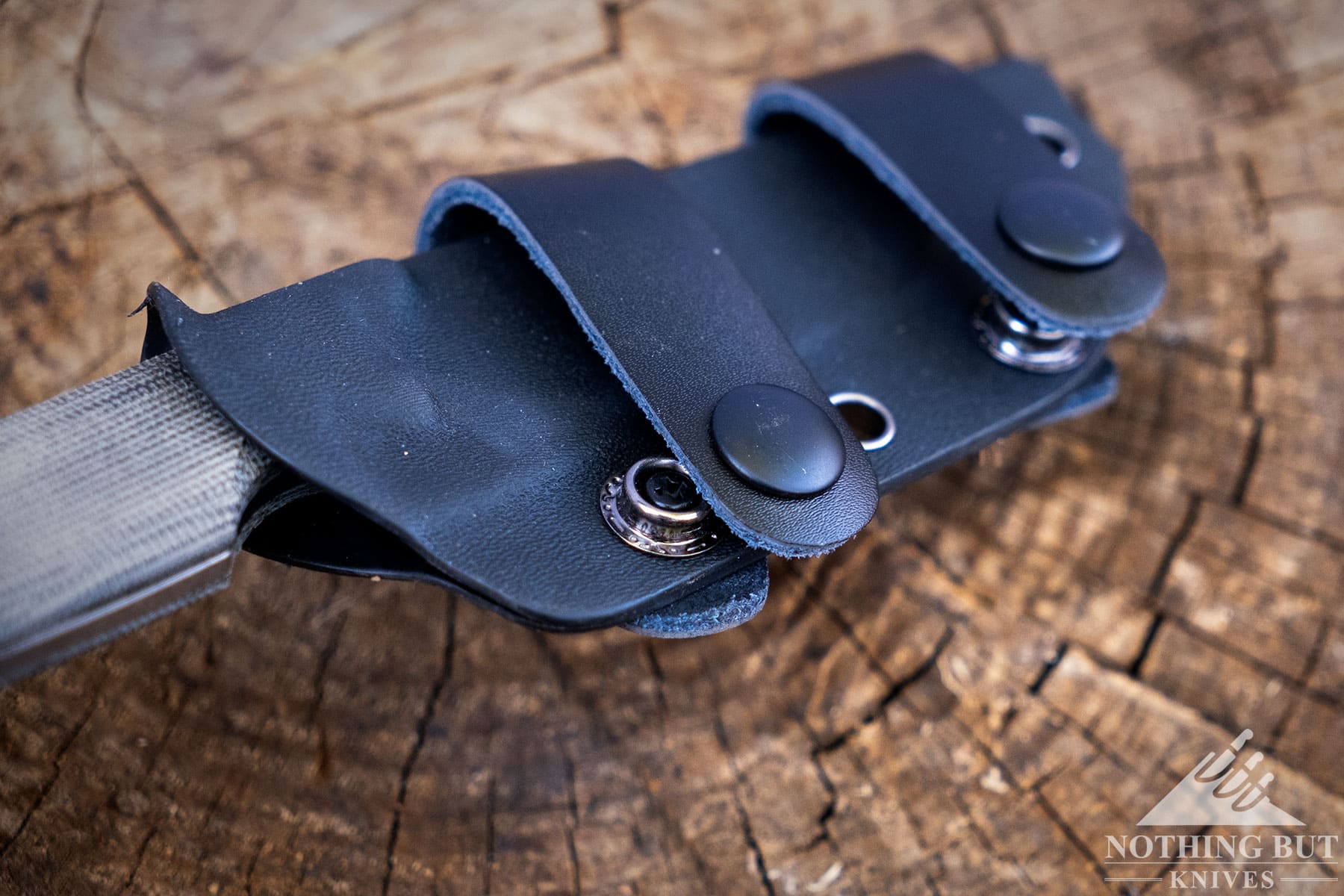
- Simple solution for horizontal carry
- Easy to remove or replace
This pretty much locks a sheath into horizontal carry unless you get creative. Otherwise it’s a nice, simple solution for appendix and scout carry. So long as you have a somewhat thick belt, the straps have a tight fit. They’re a little looser with nylon straps, but the buttons have a strong retention.
Button-Lock Clasp
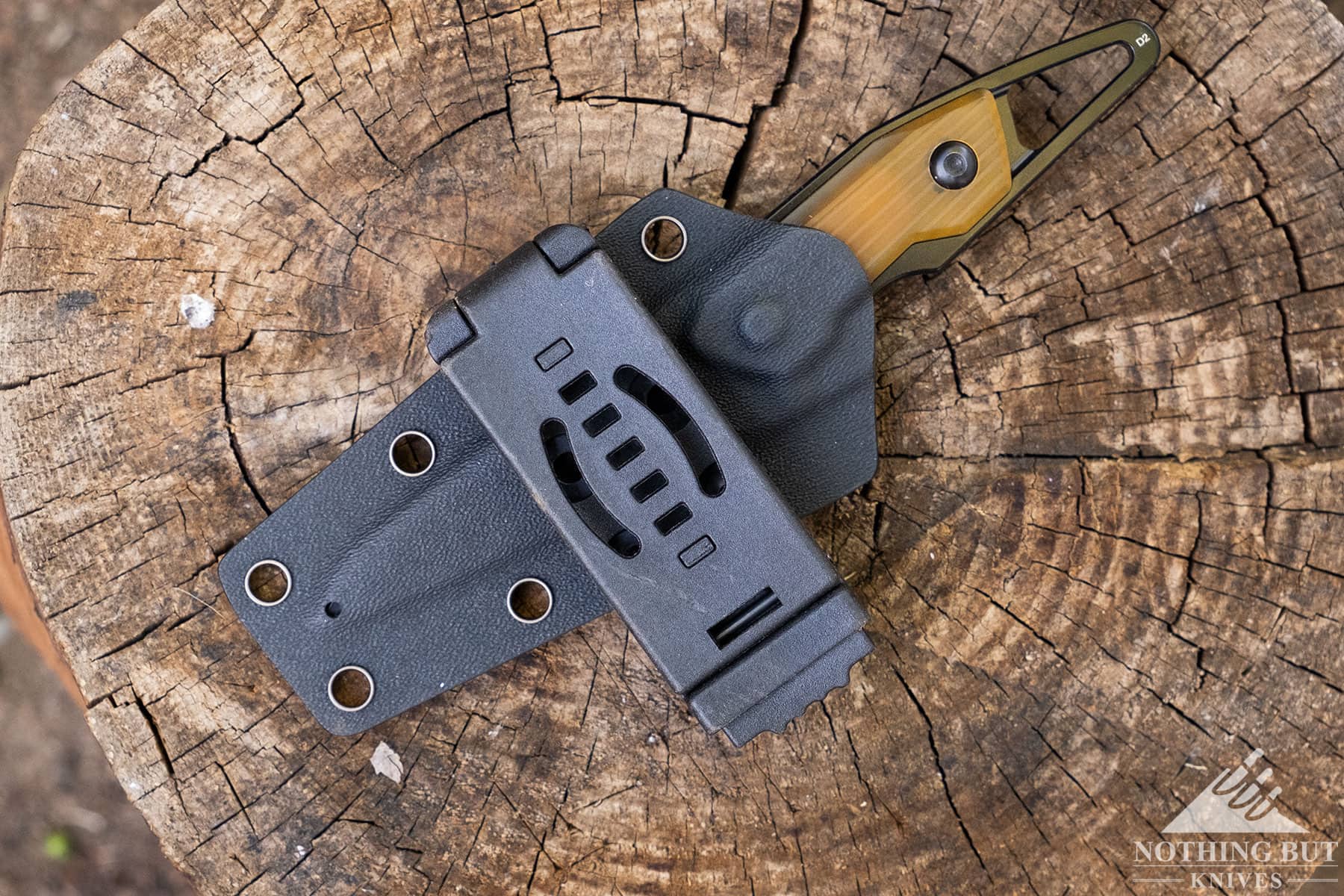
- Easy to lock onto belt
- Tight hold makes it good for MOLLE
Anyone familiar with Tek Loks should be comfortable with these things. It has a button clasp so you can easily mount and take off the knife, and there are plastic spacers inside so you can adjust the width for whatever belt you’re wearing.
Blade Smith Series vs. Vanguard
You might have noticed some of these knives have multiple steel and handle options listed in the table. That usually means Kizer has the model under their Vanguard line (the budget and standard side of Kizer) and their Blade Smith line (the premium side).
Typically knives in the Vanguard category will have G10 scales and D2 or Nitro-V steel, and pretty reliably come under $100, while the Blade Smith knives will get fancy with titanium handles, milled pocket clips, and high-wear powder steels like CPM-S35VN.
Fixed Blade Designer Index
Almost every fixed blade has a named designer behind it, so we made a table to help ourselves keep track. Then we realized other people might also find it useful.
| Alikhanov Adil | Artur Szula | Azo Mai | Dirk Pinkerton | Derek Sharon | Eddie Diez | Henning Marxen | James Buckley | Jonathan Styles | Maciej Torbe | Tyler Barnes |
| Metaproptizol | Magara | Begleiter | Variable | Muskrat | Shark Tooth | Bowtie | Harpoon | Smolt | Scuttler | Deckhand |
| Baby | Rocker | Sou’Wes’ | Cobbler | |||||||
| Militaw | Groom | |||||||||
| Elgon | ||||||||||
| Cabox |
